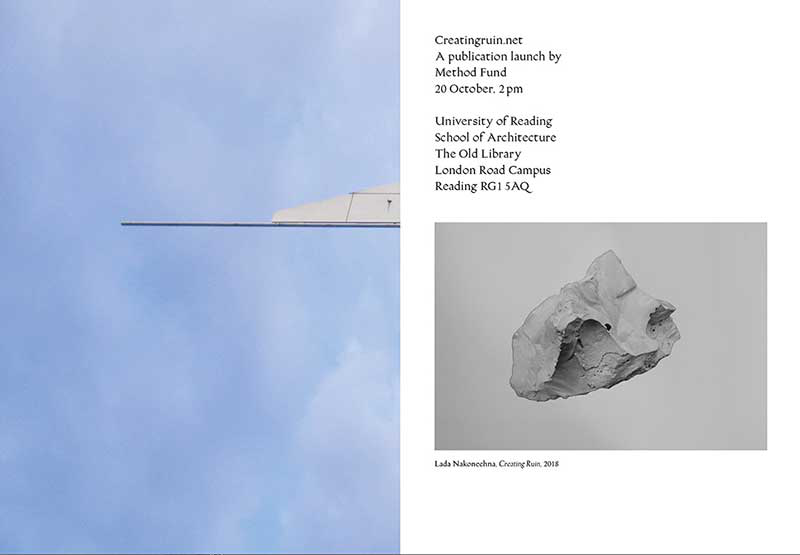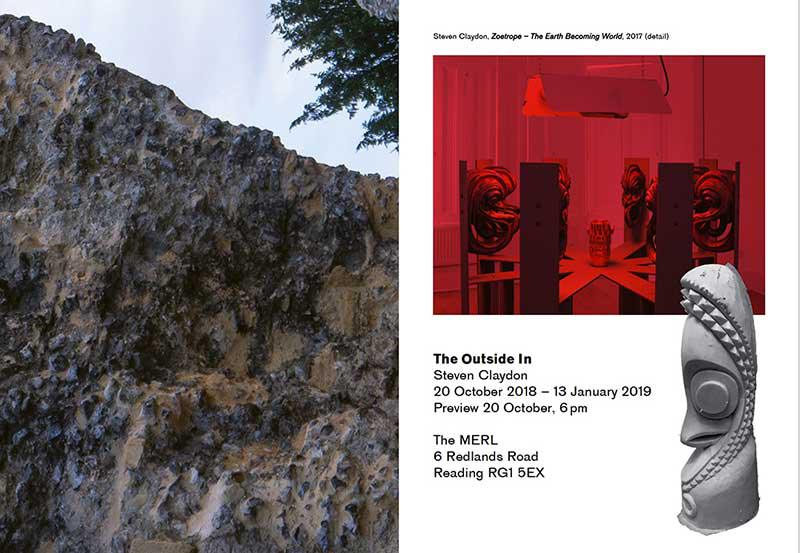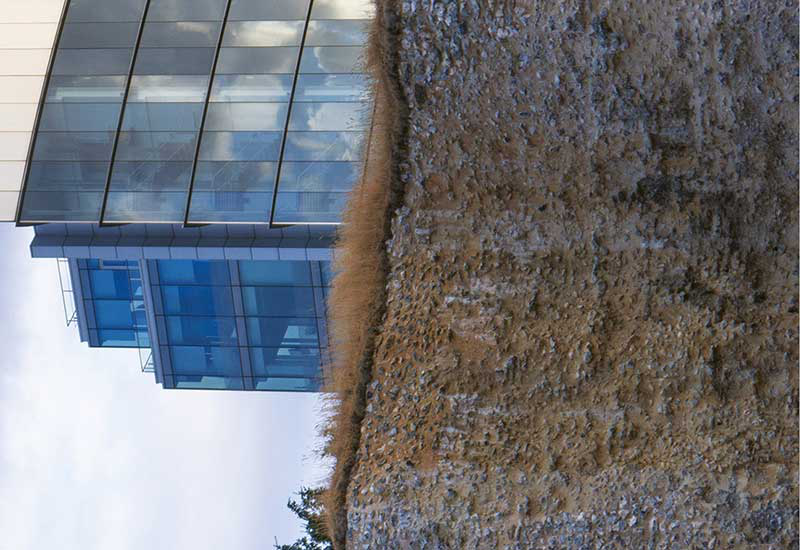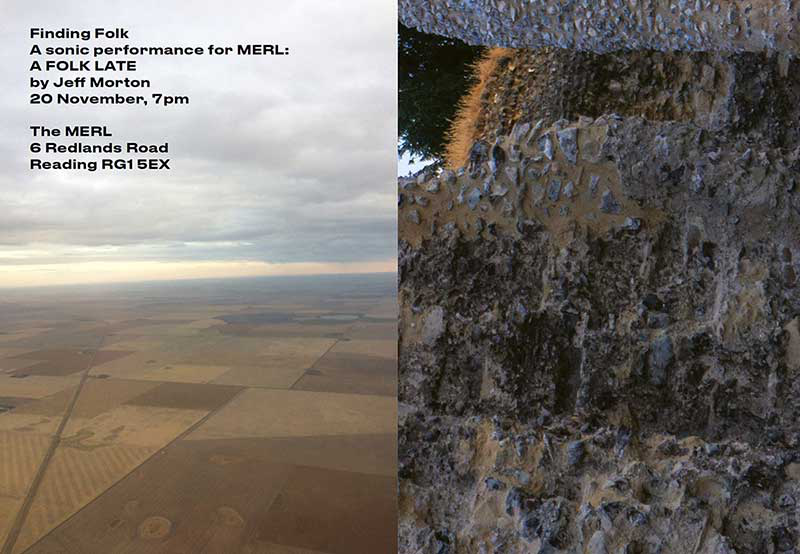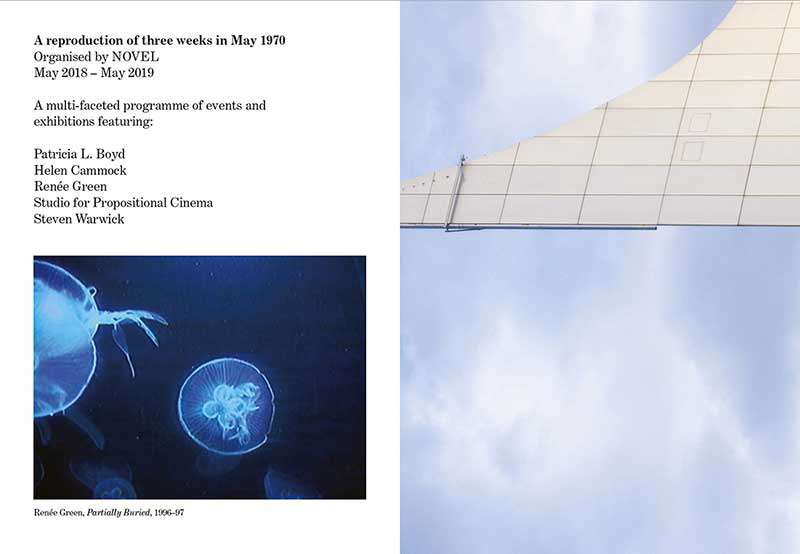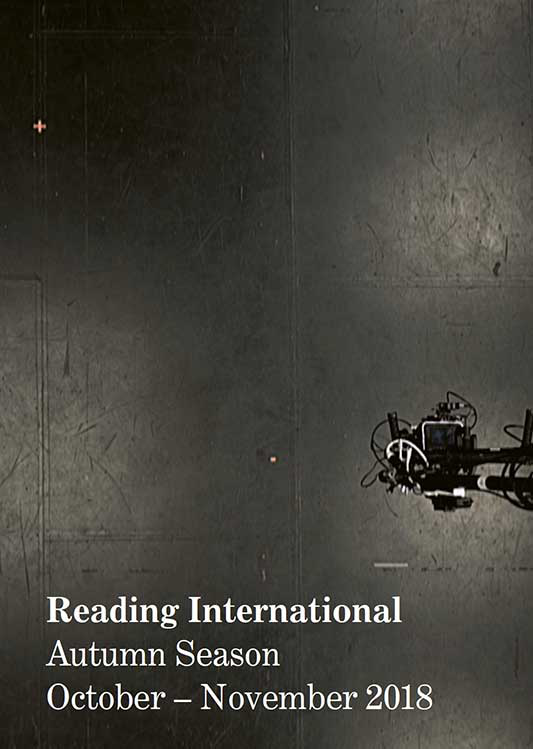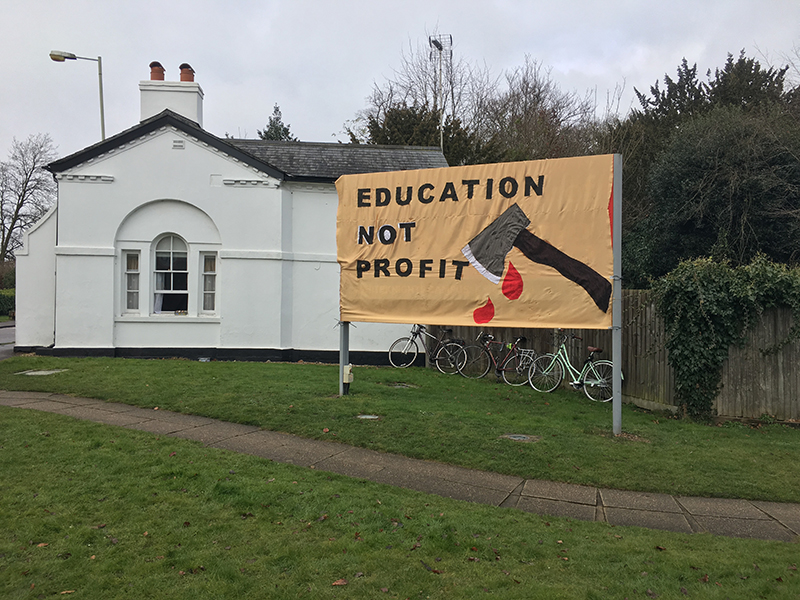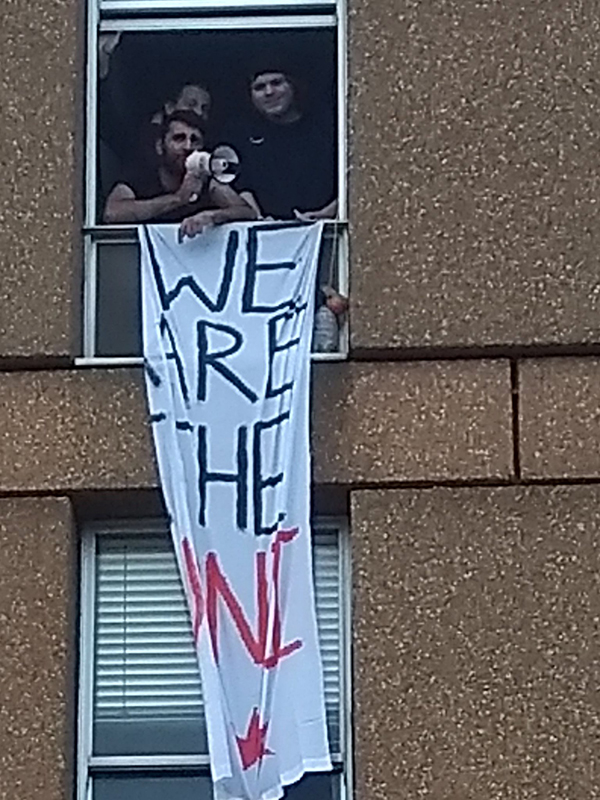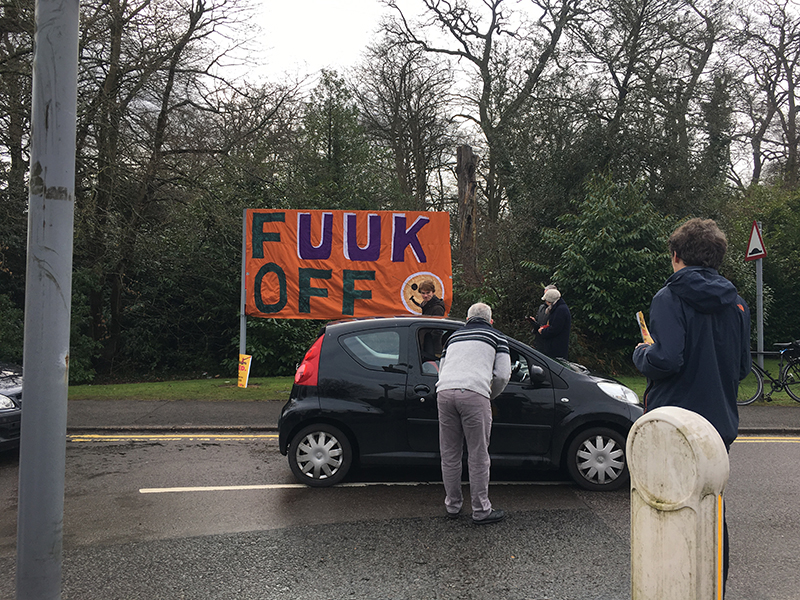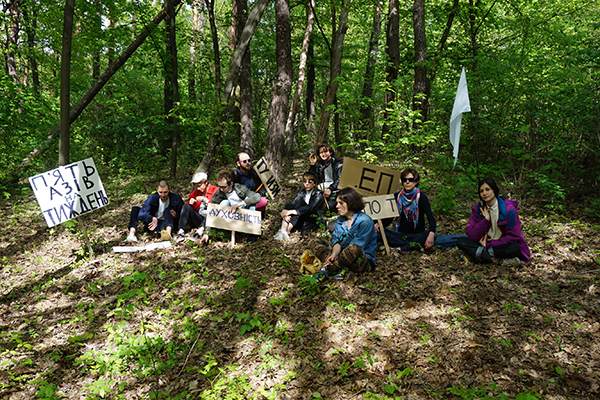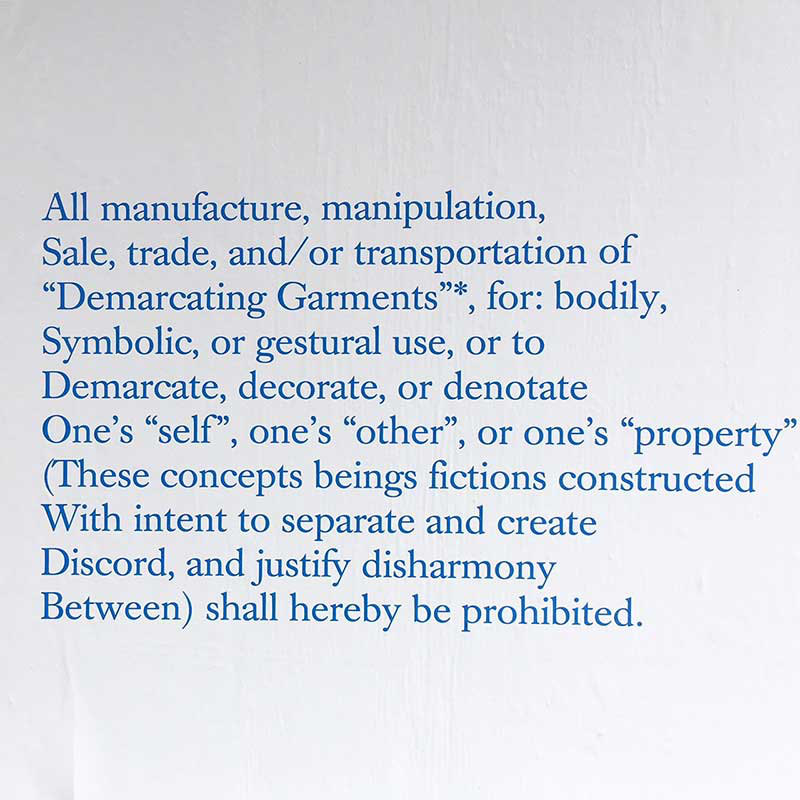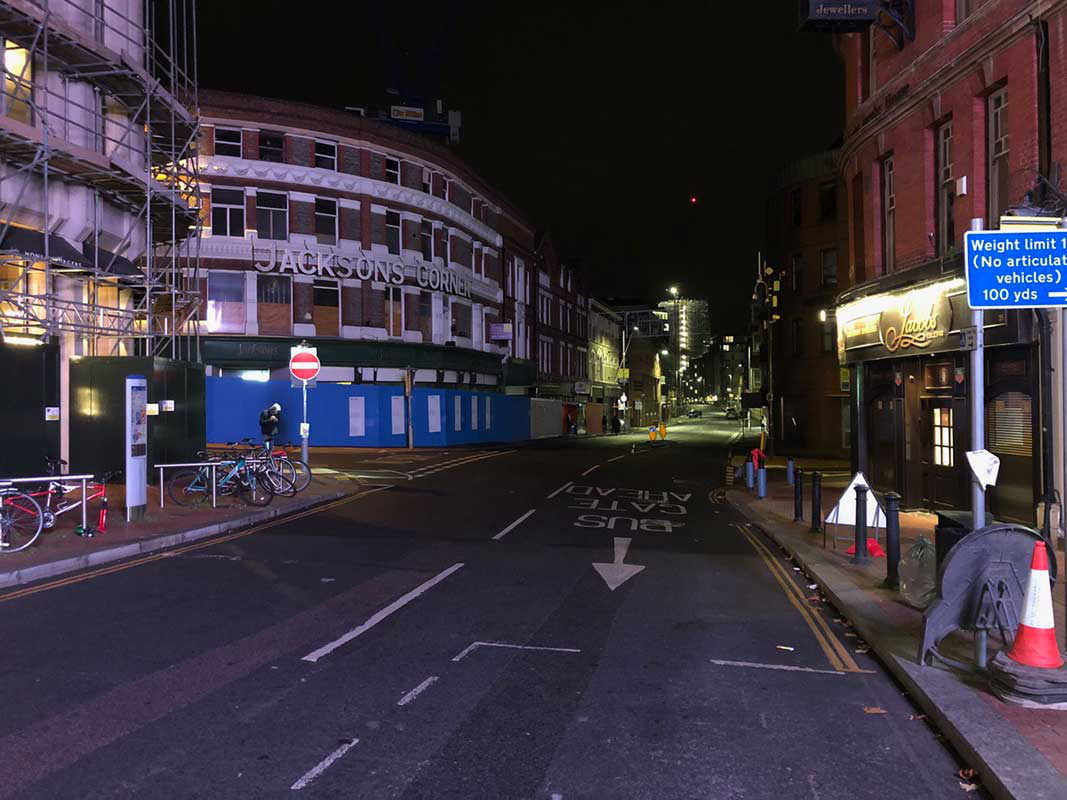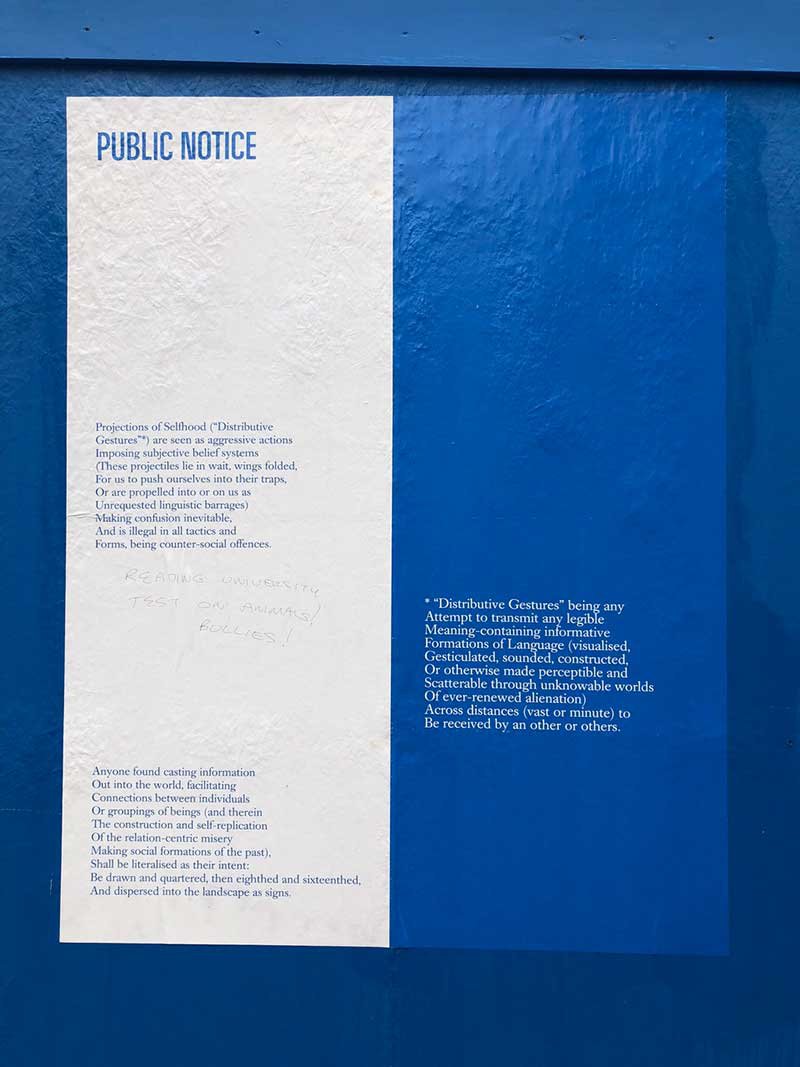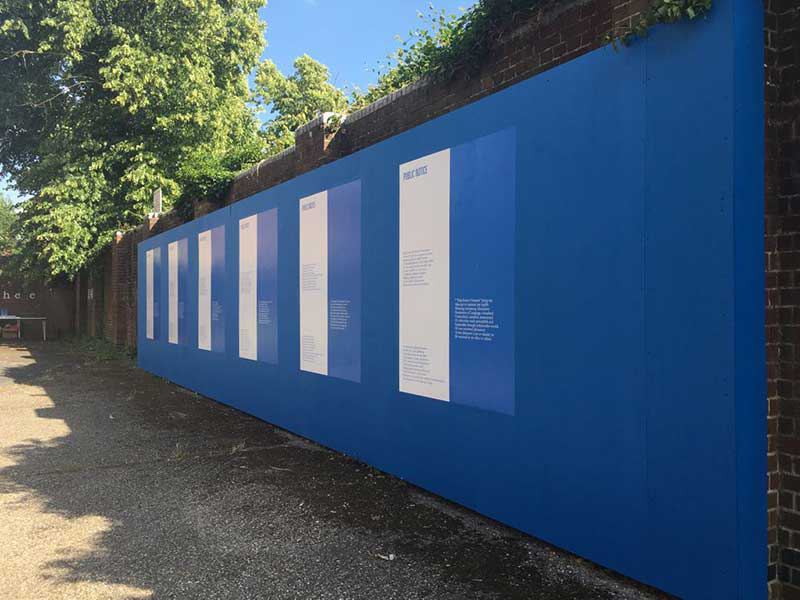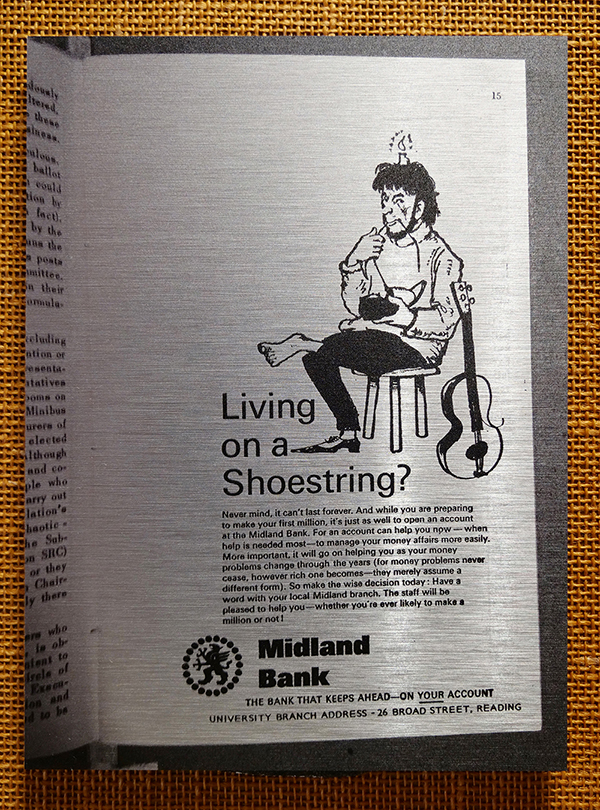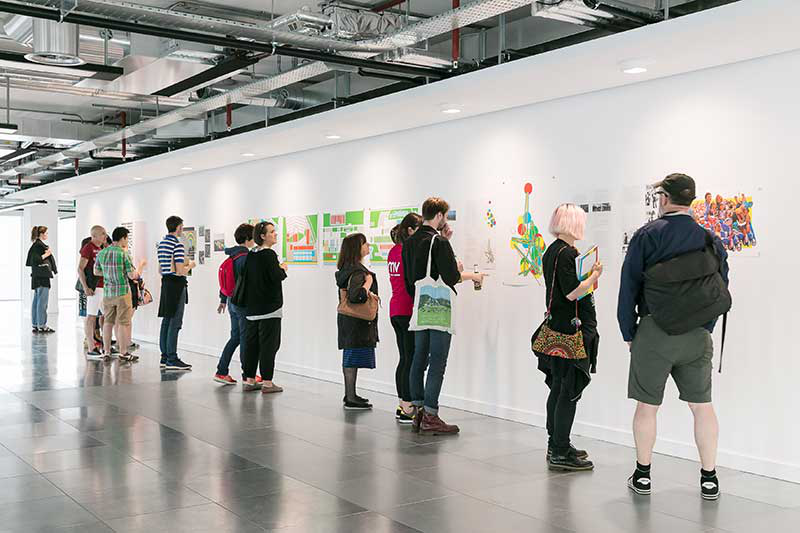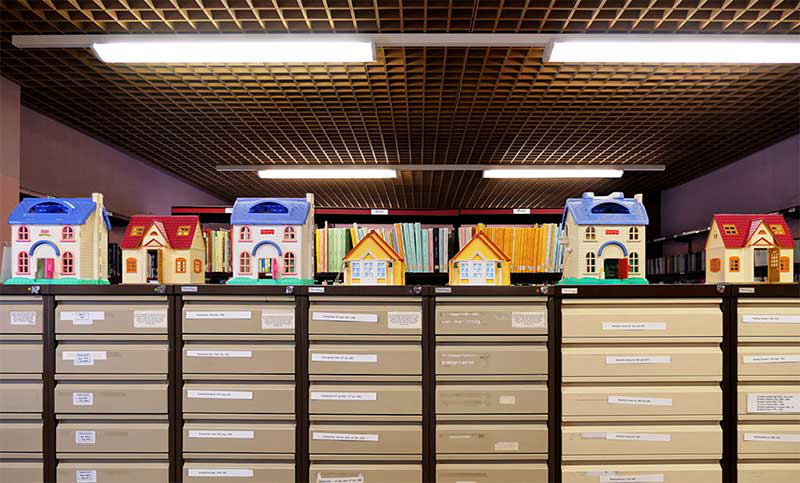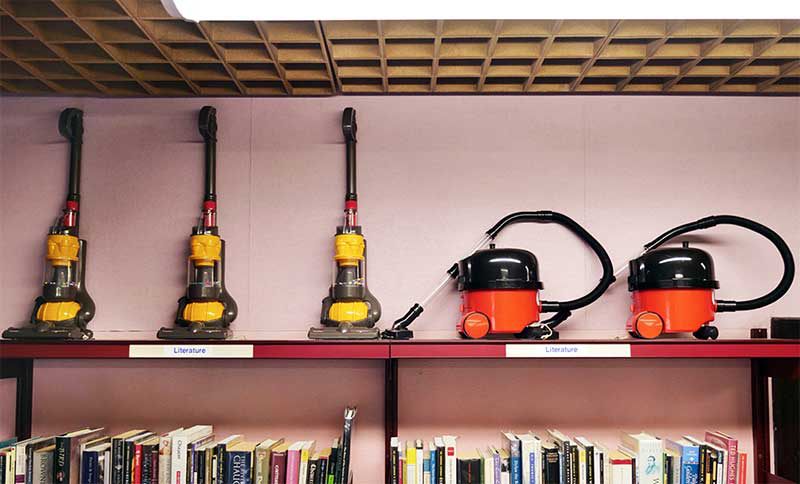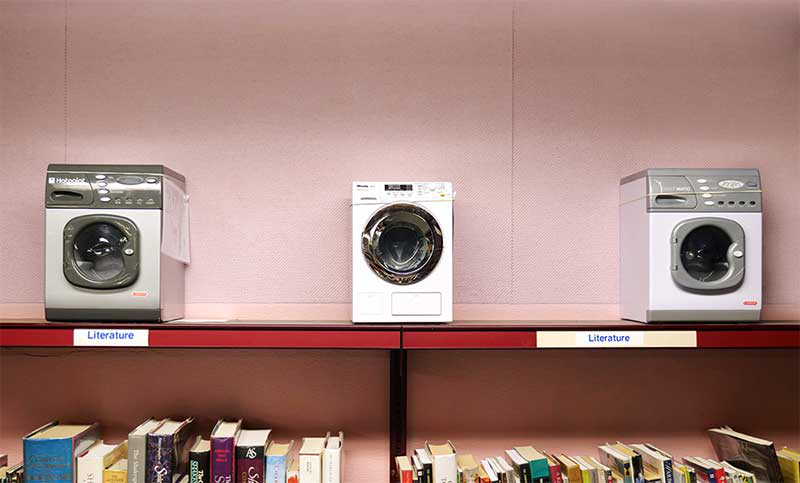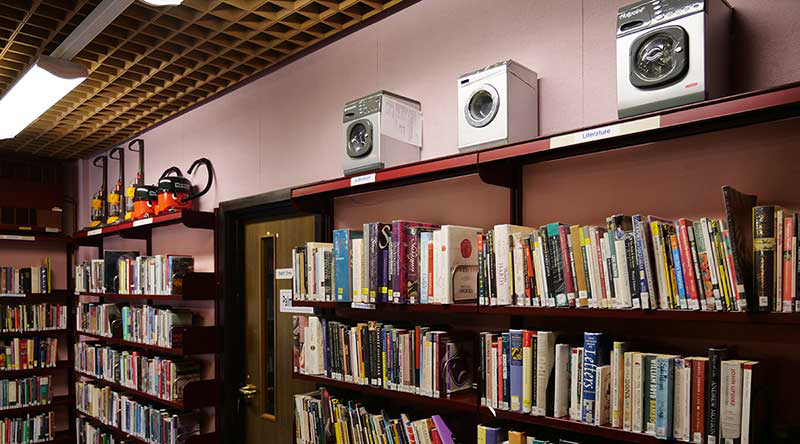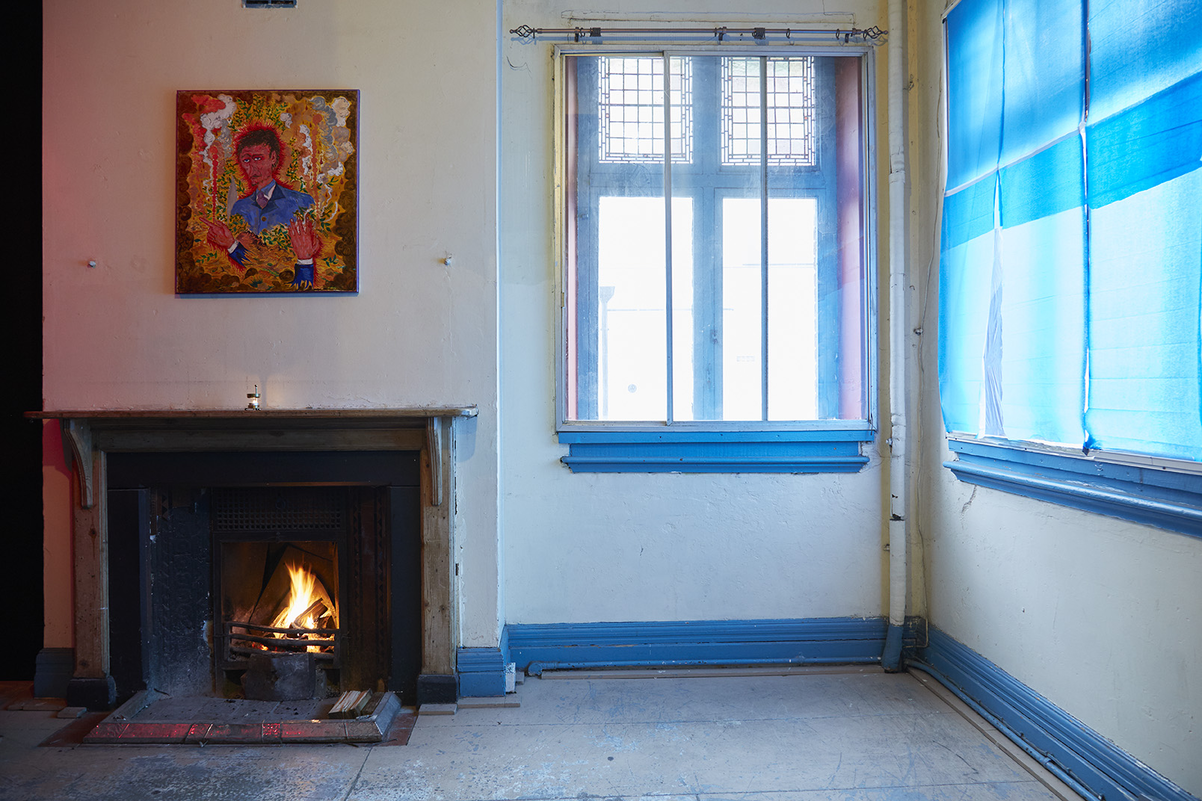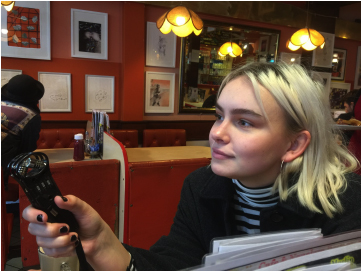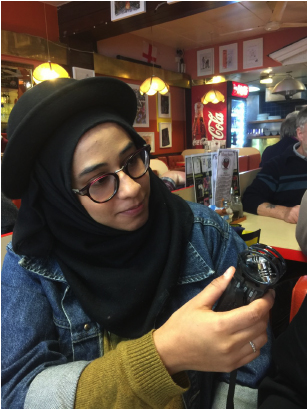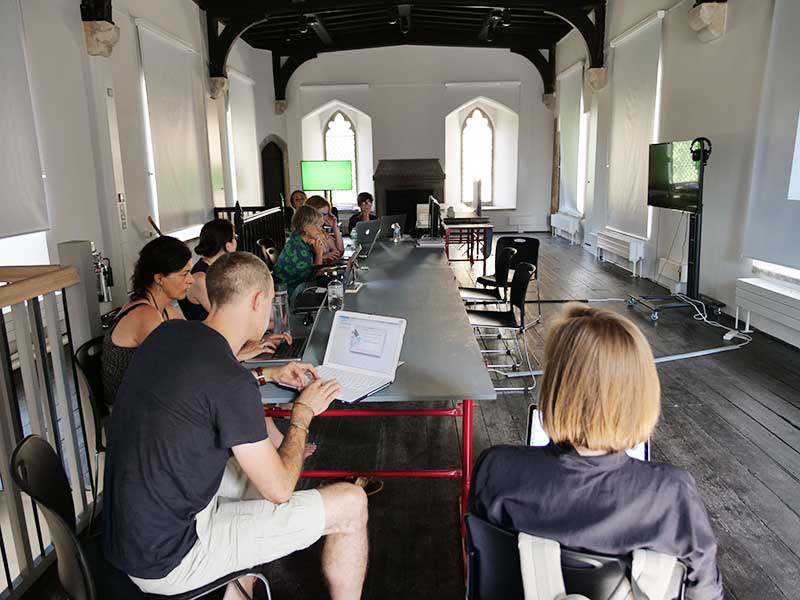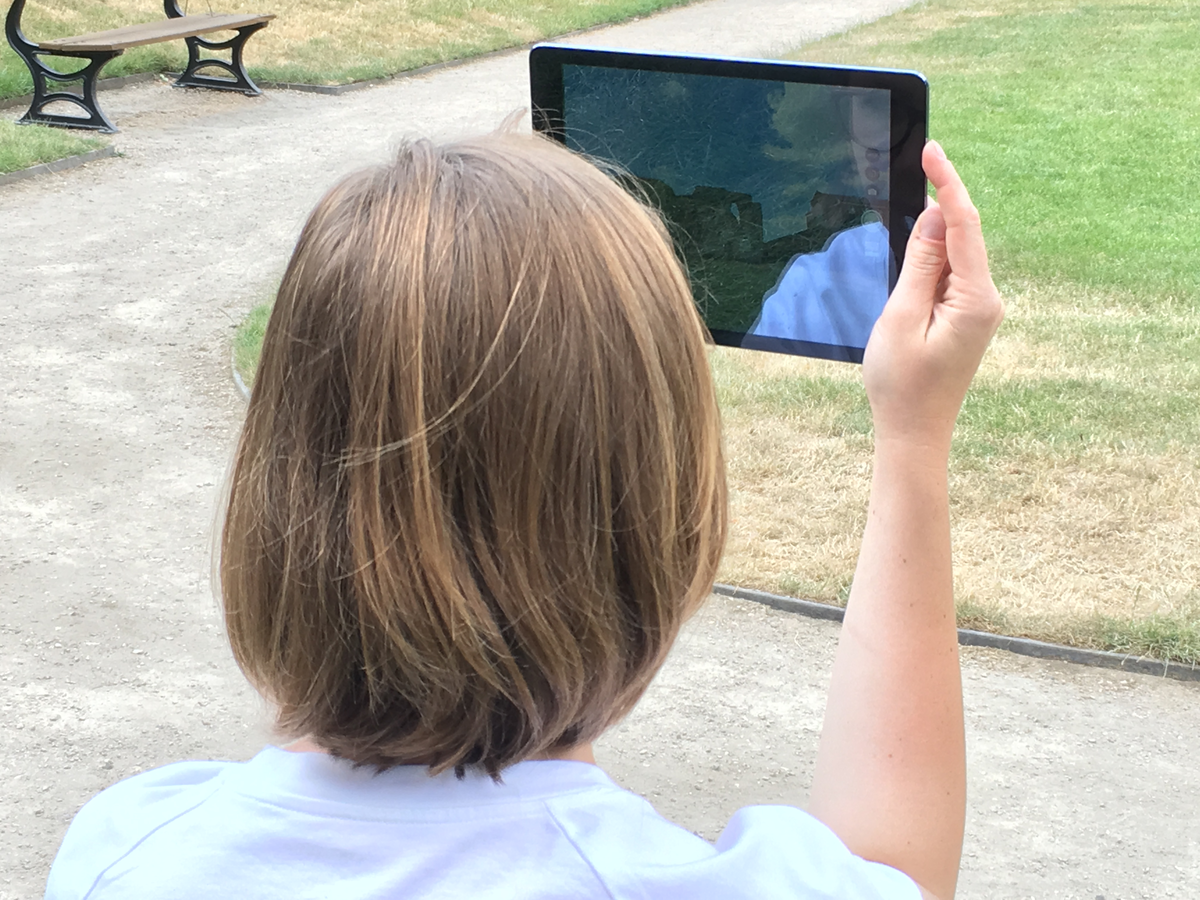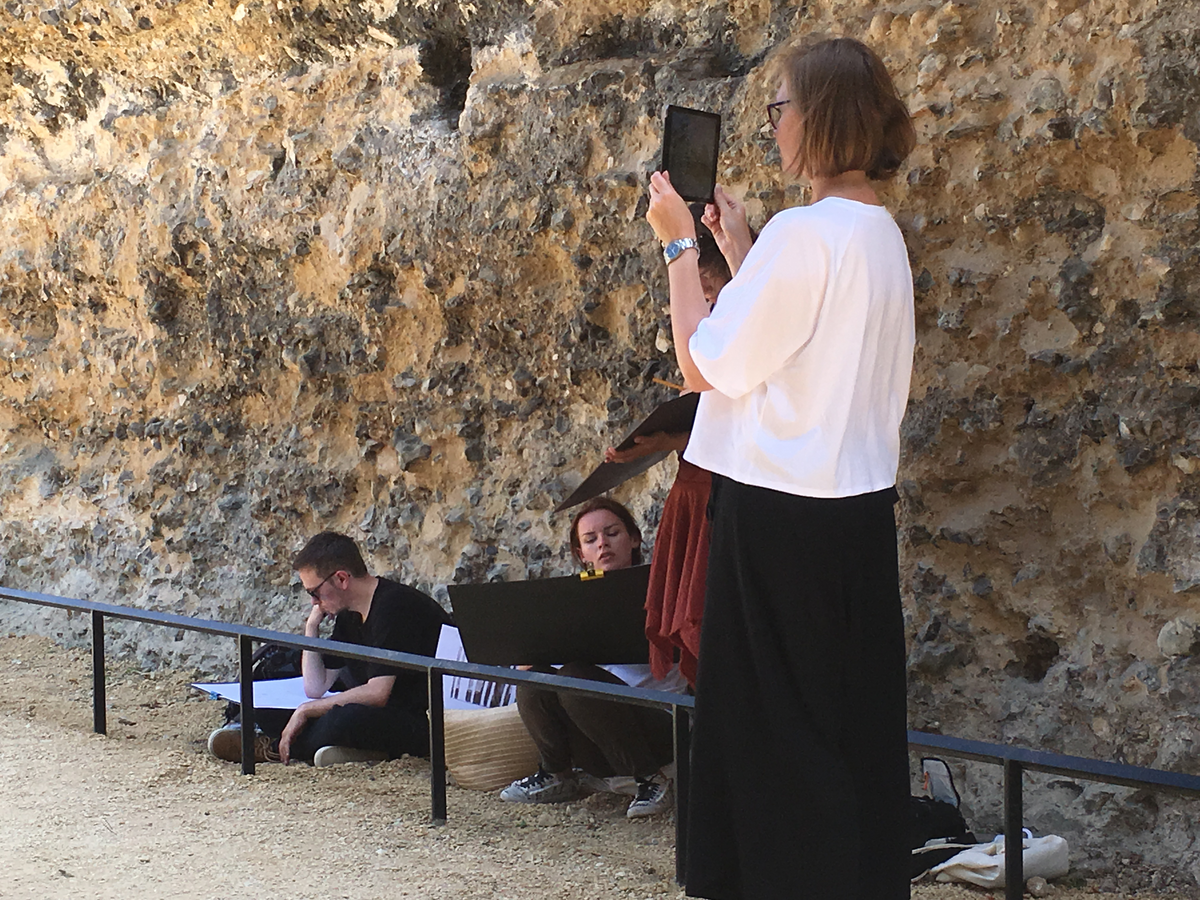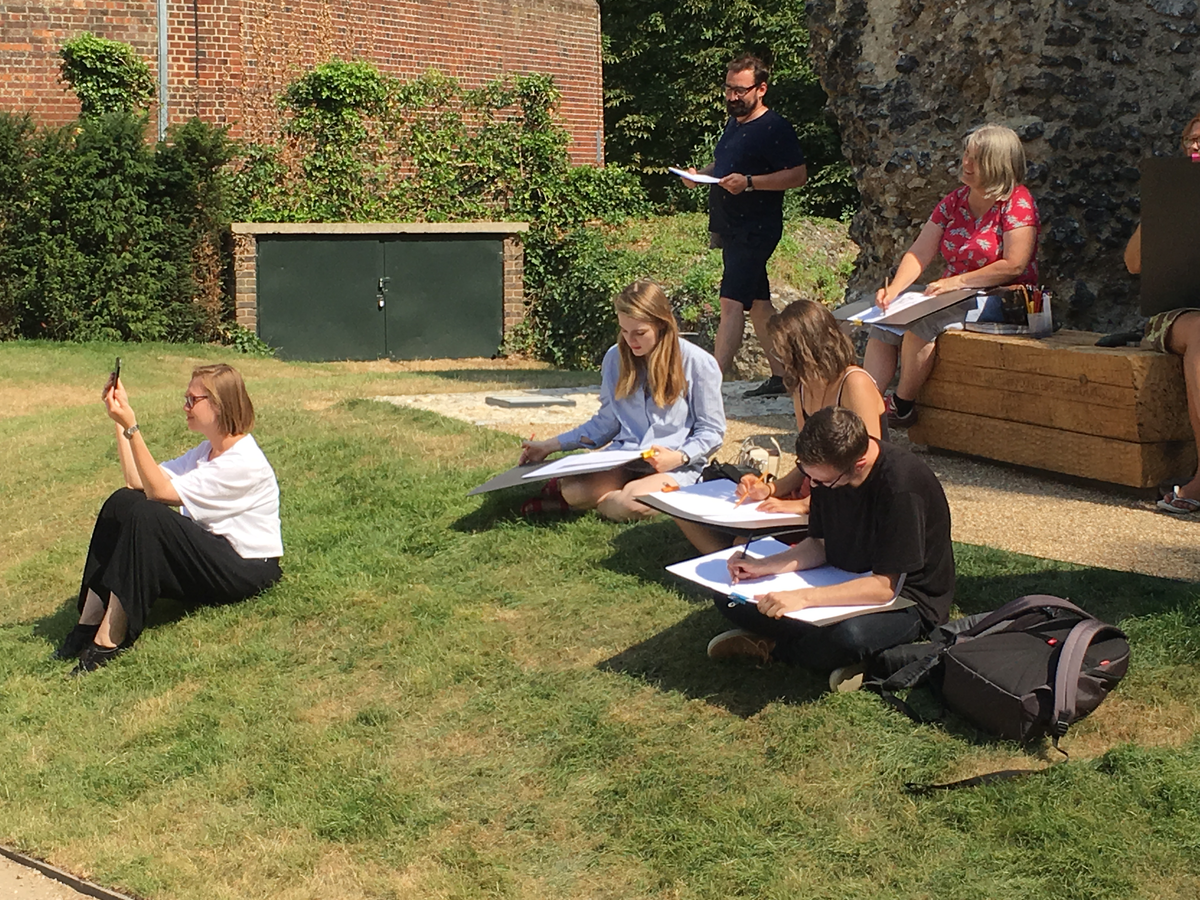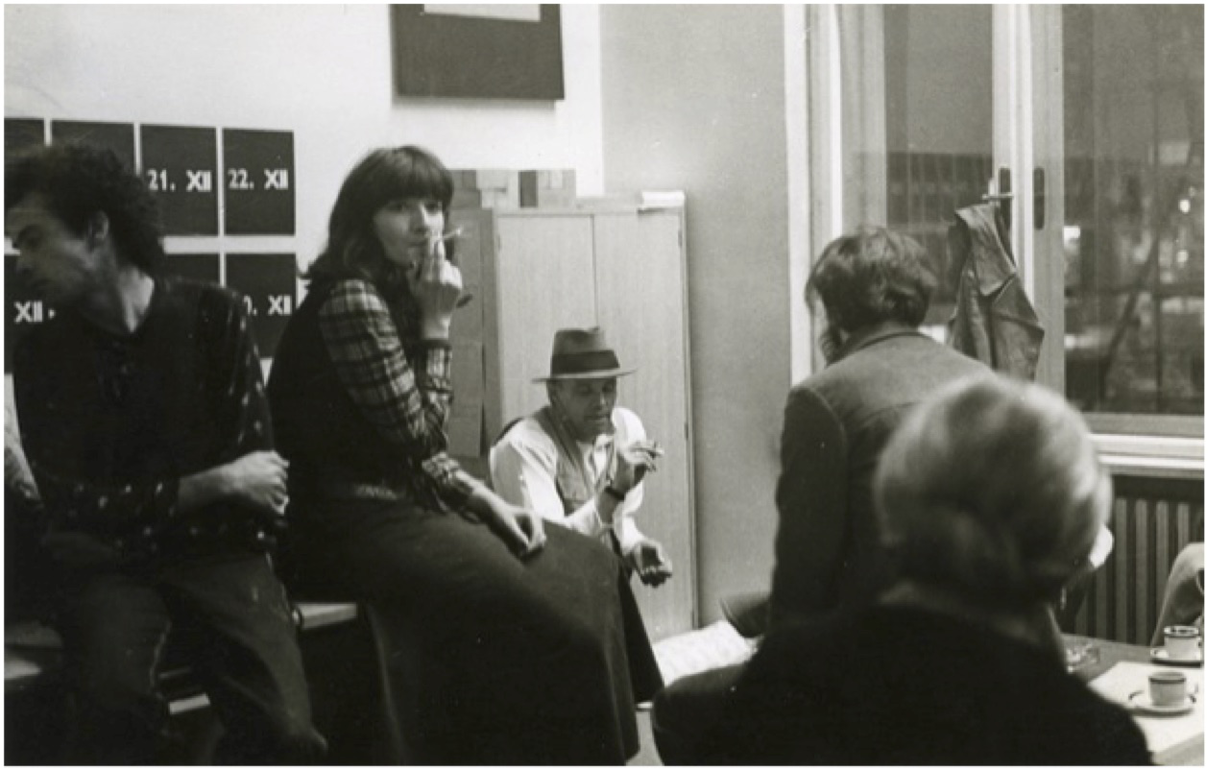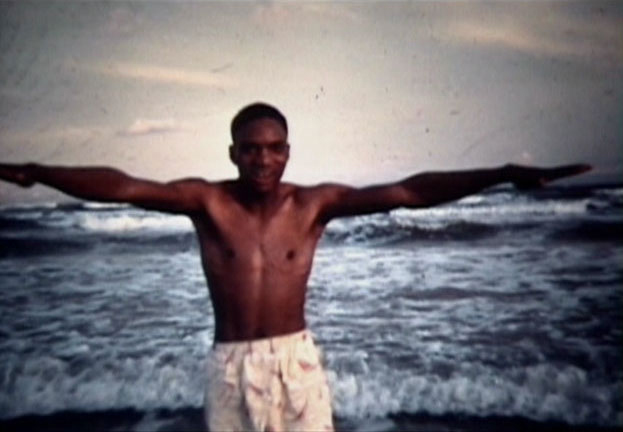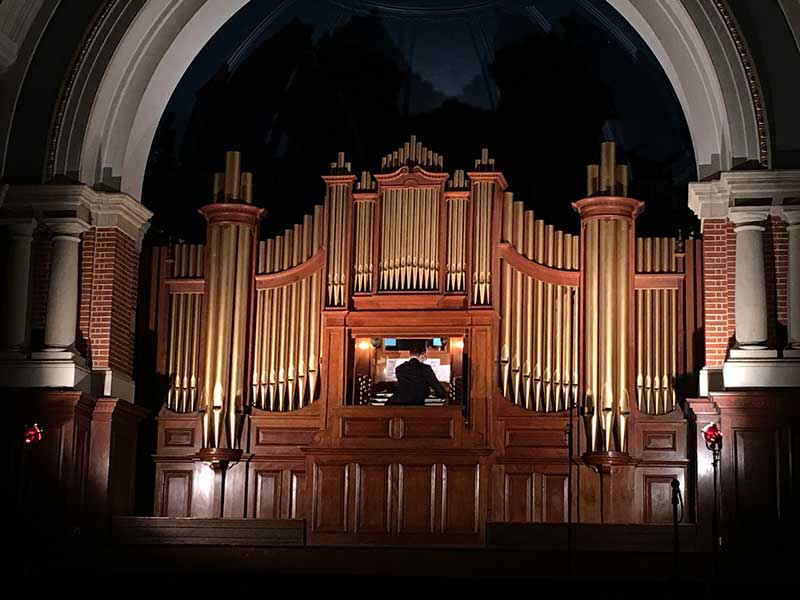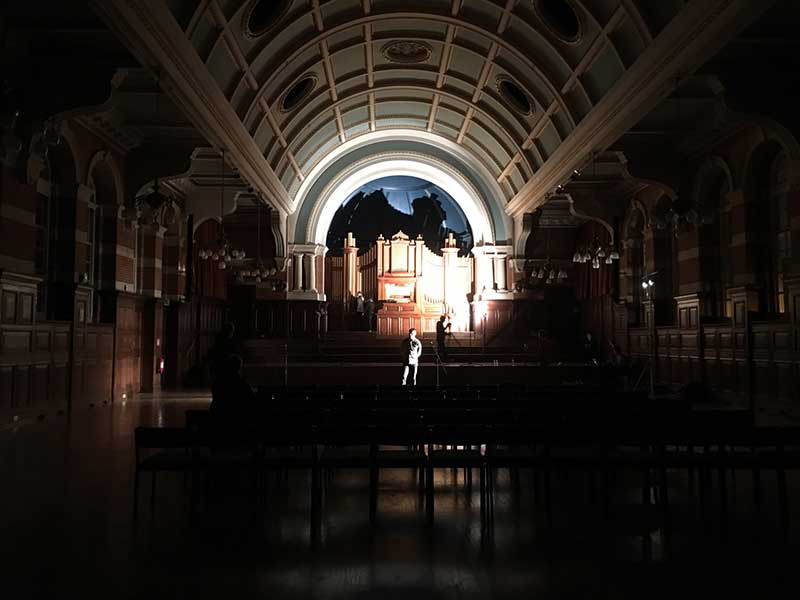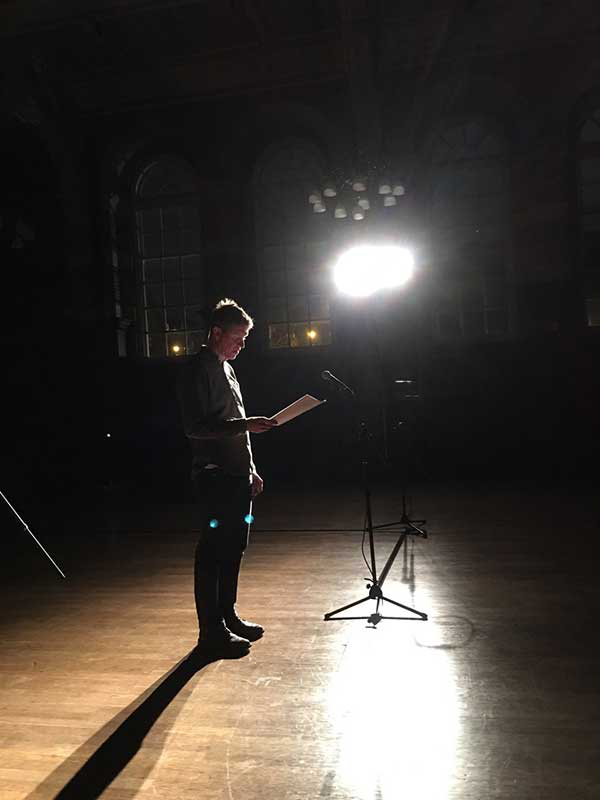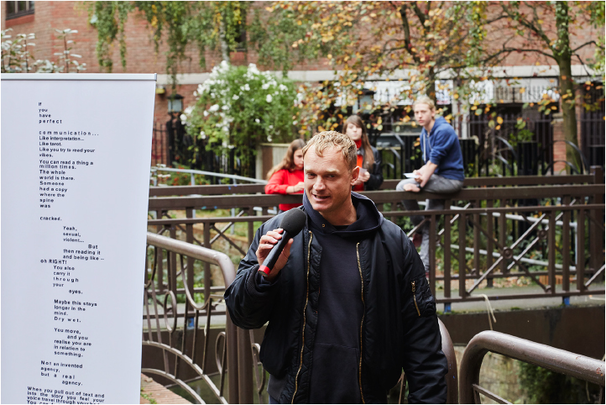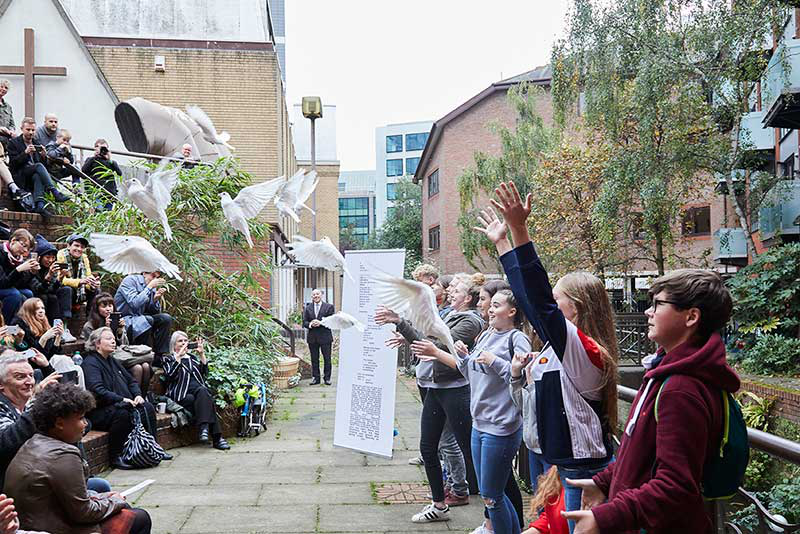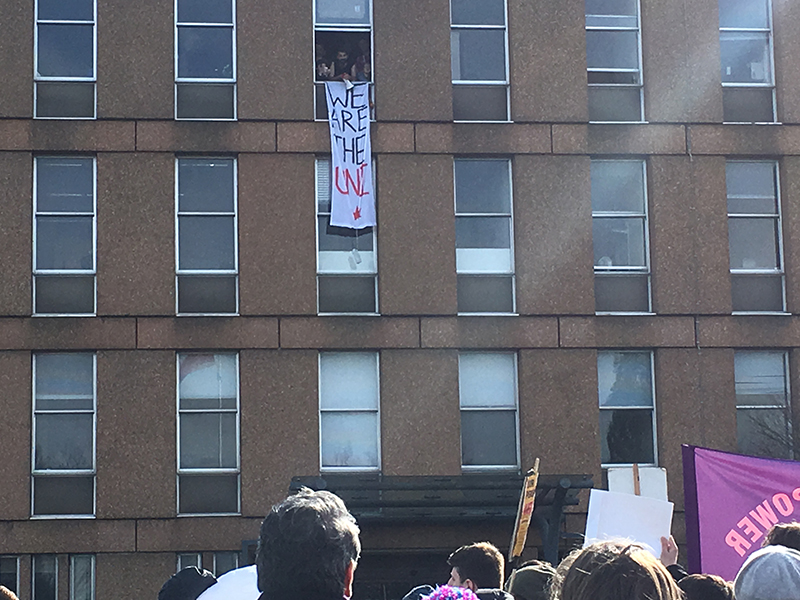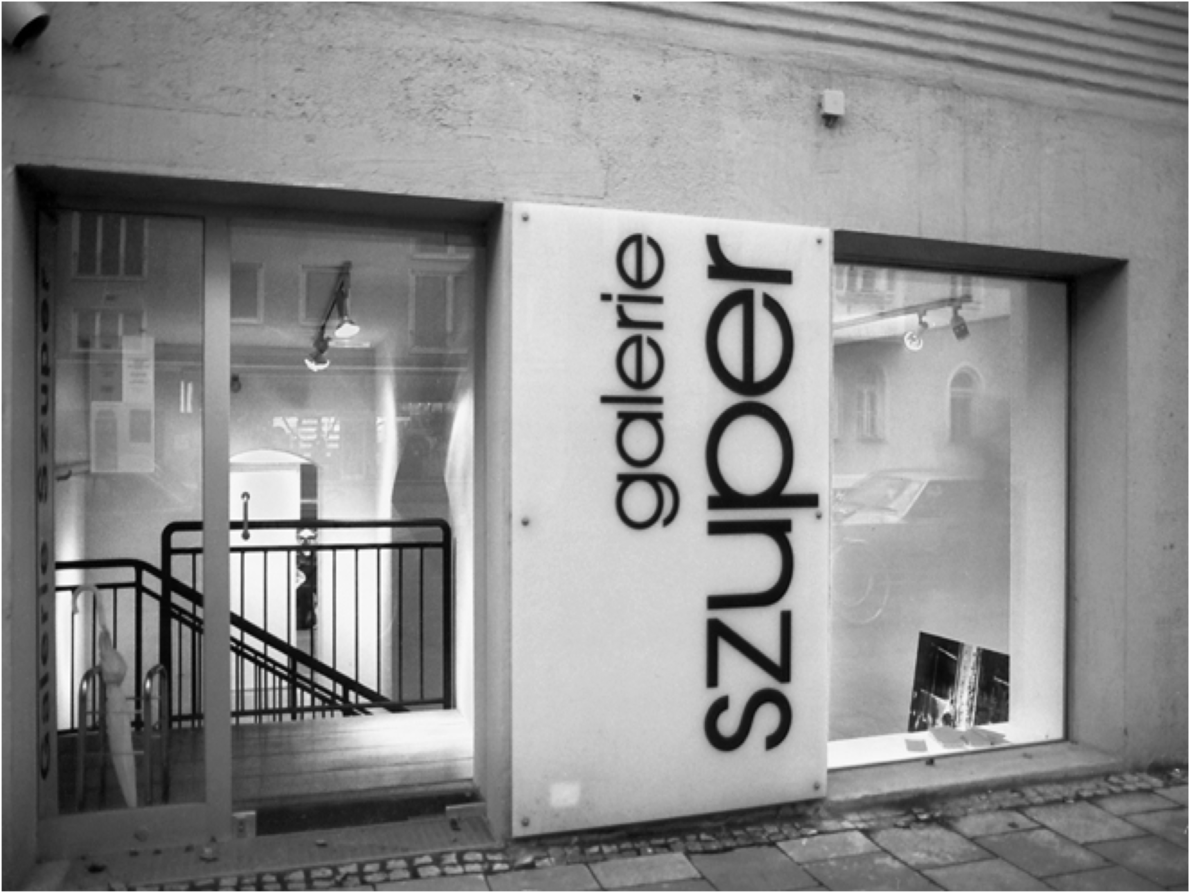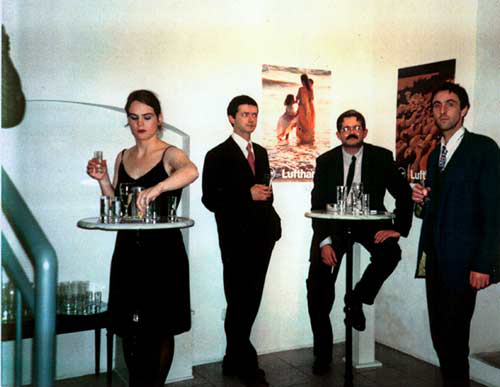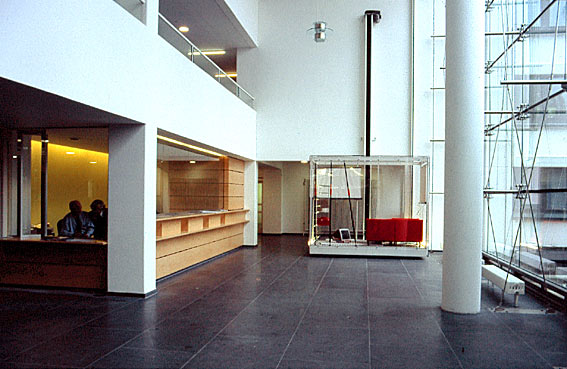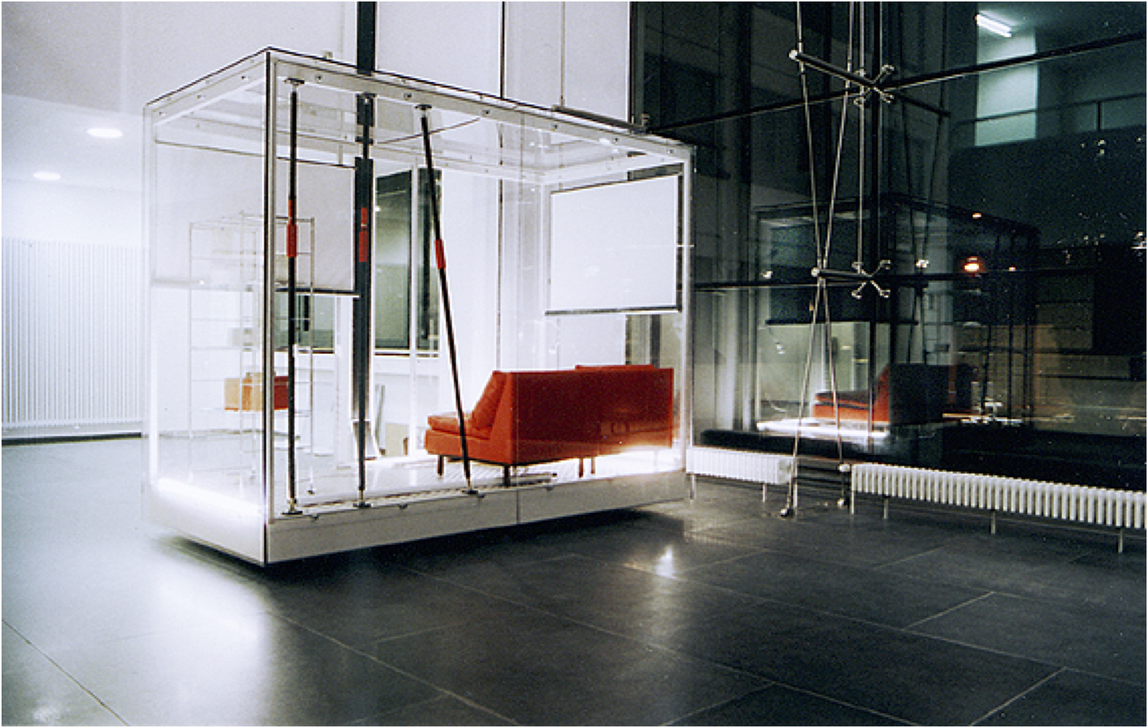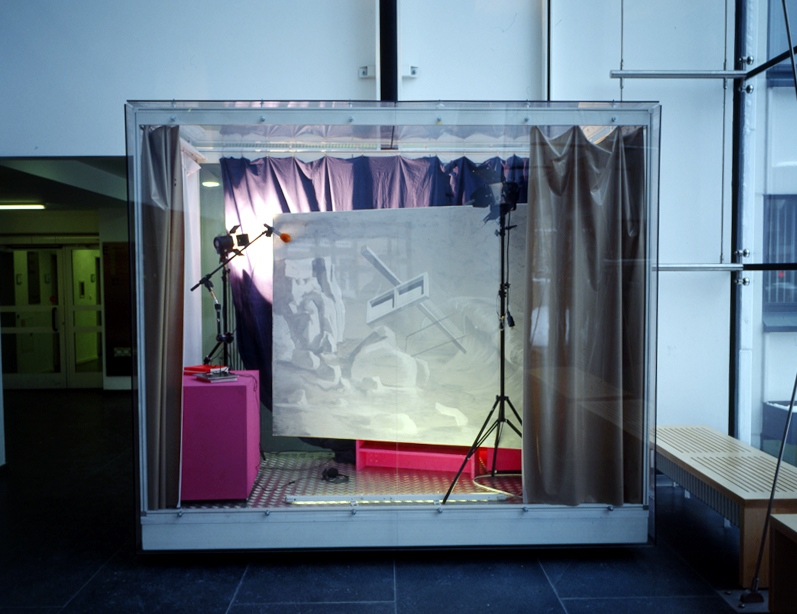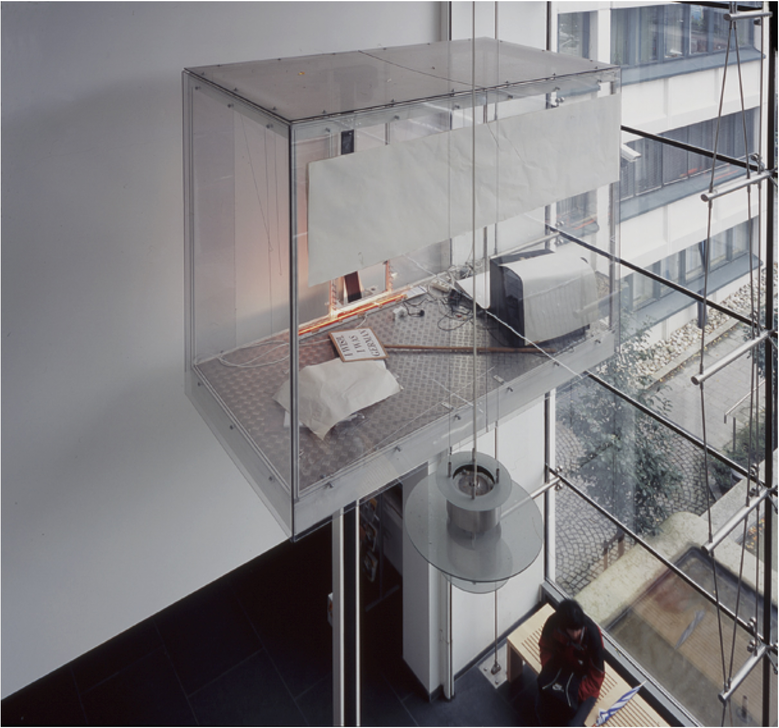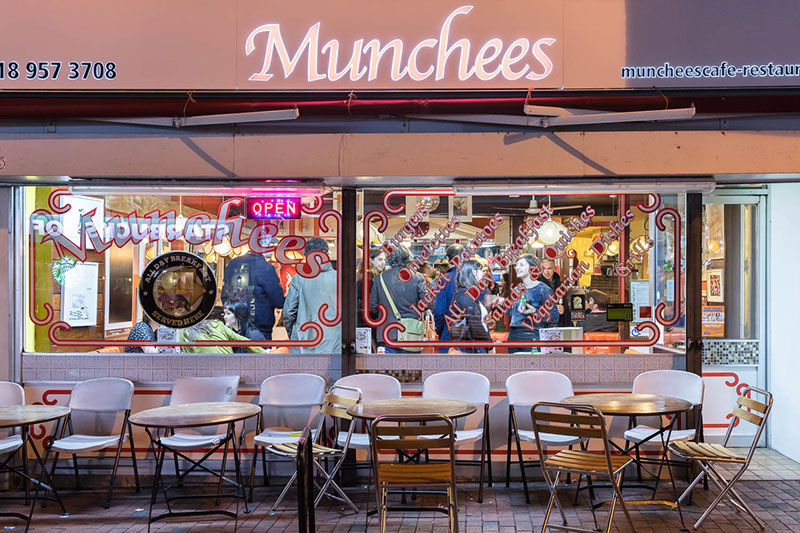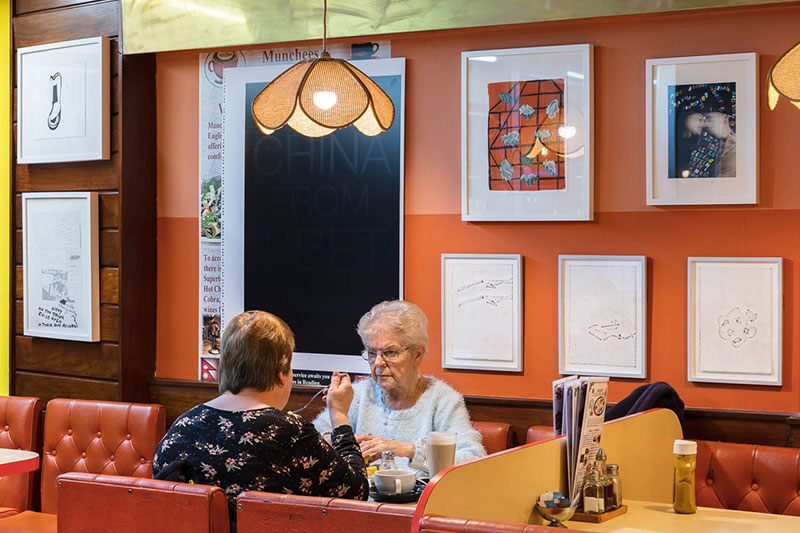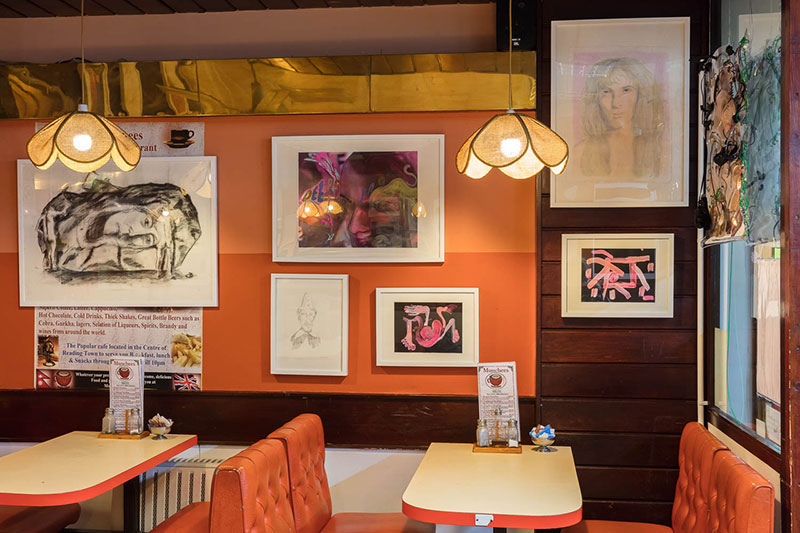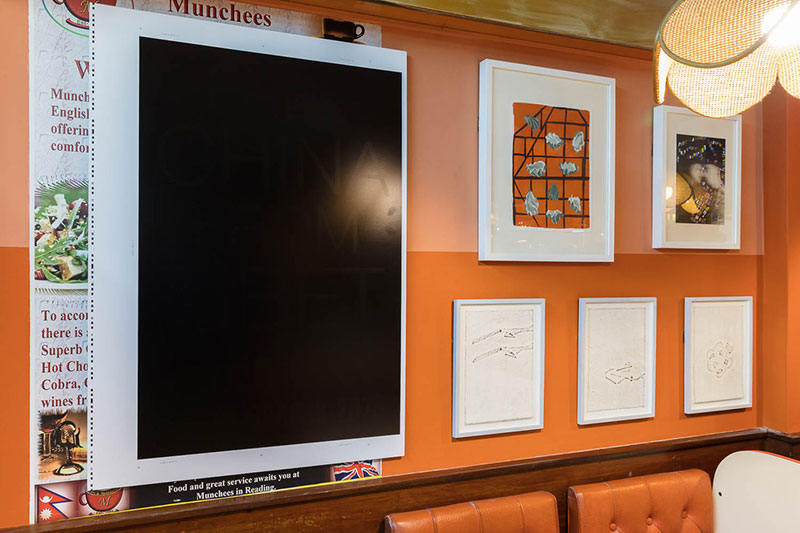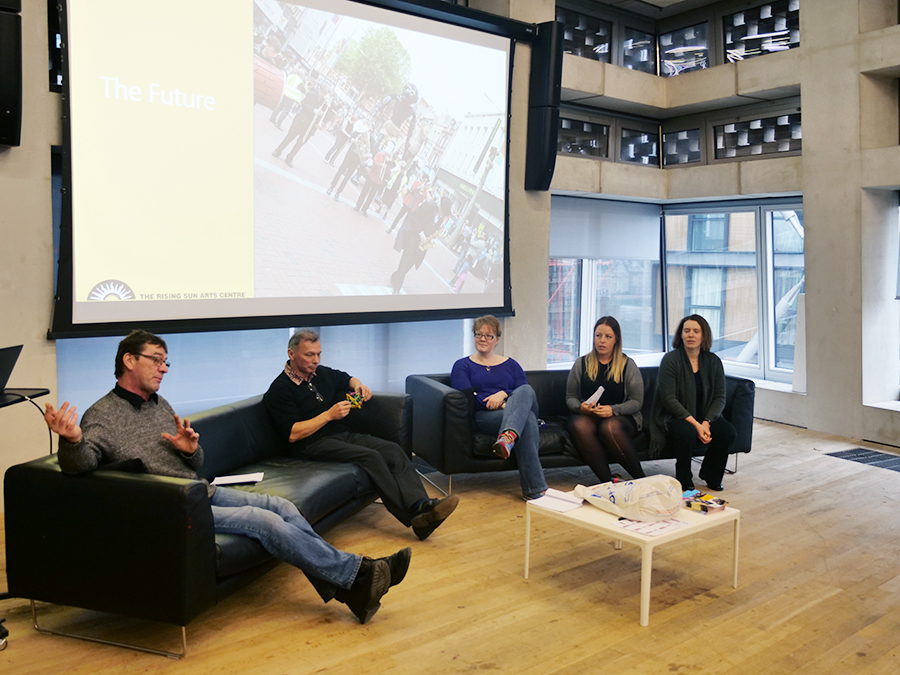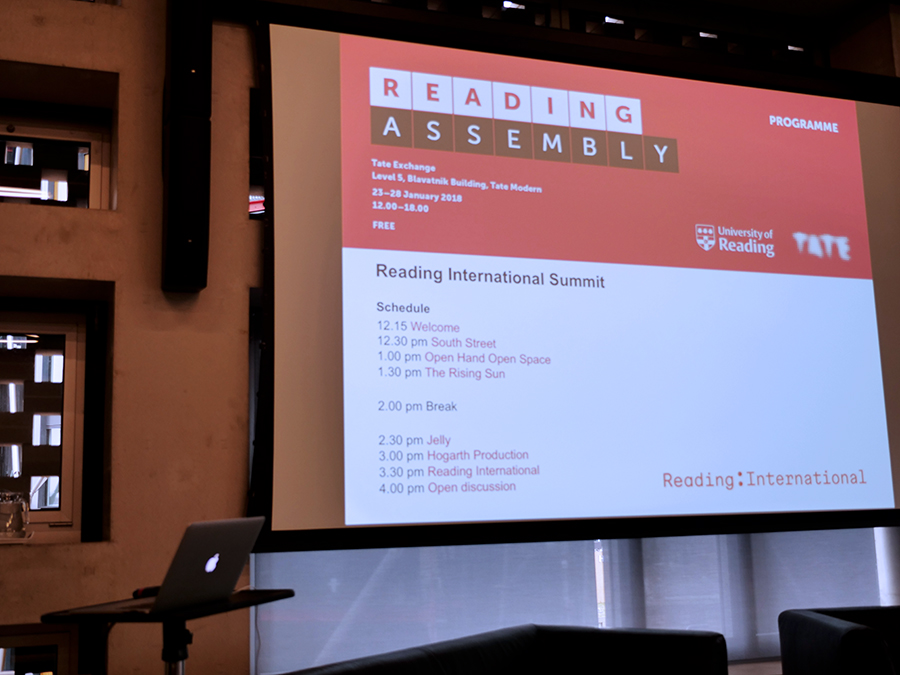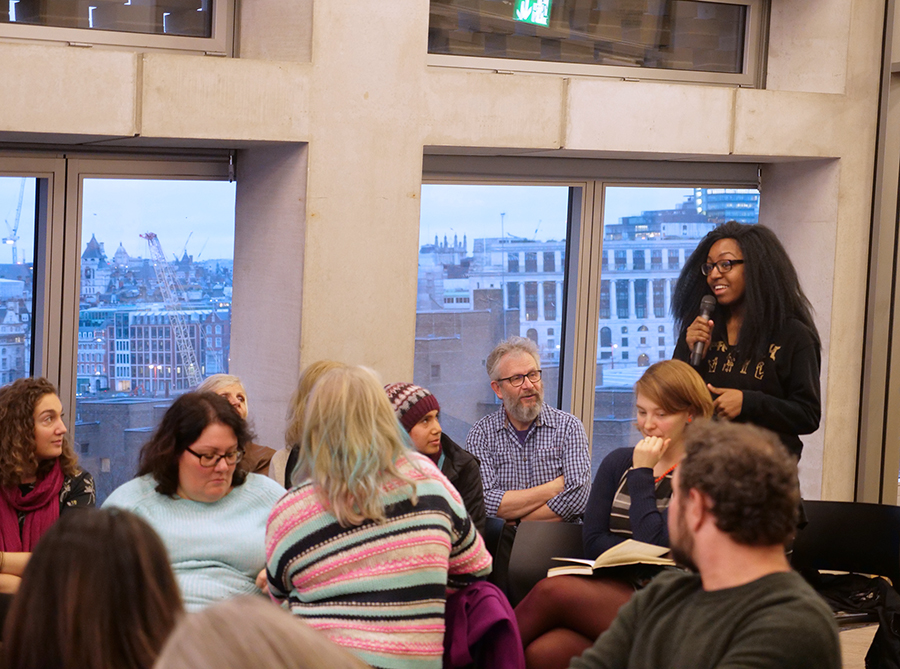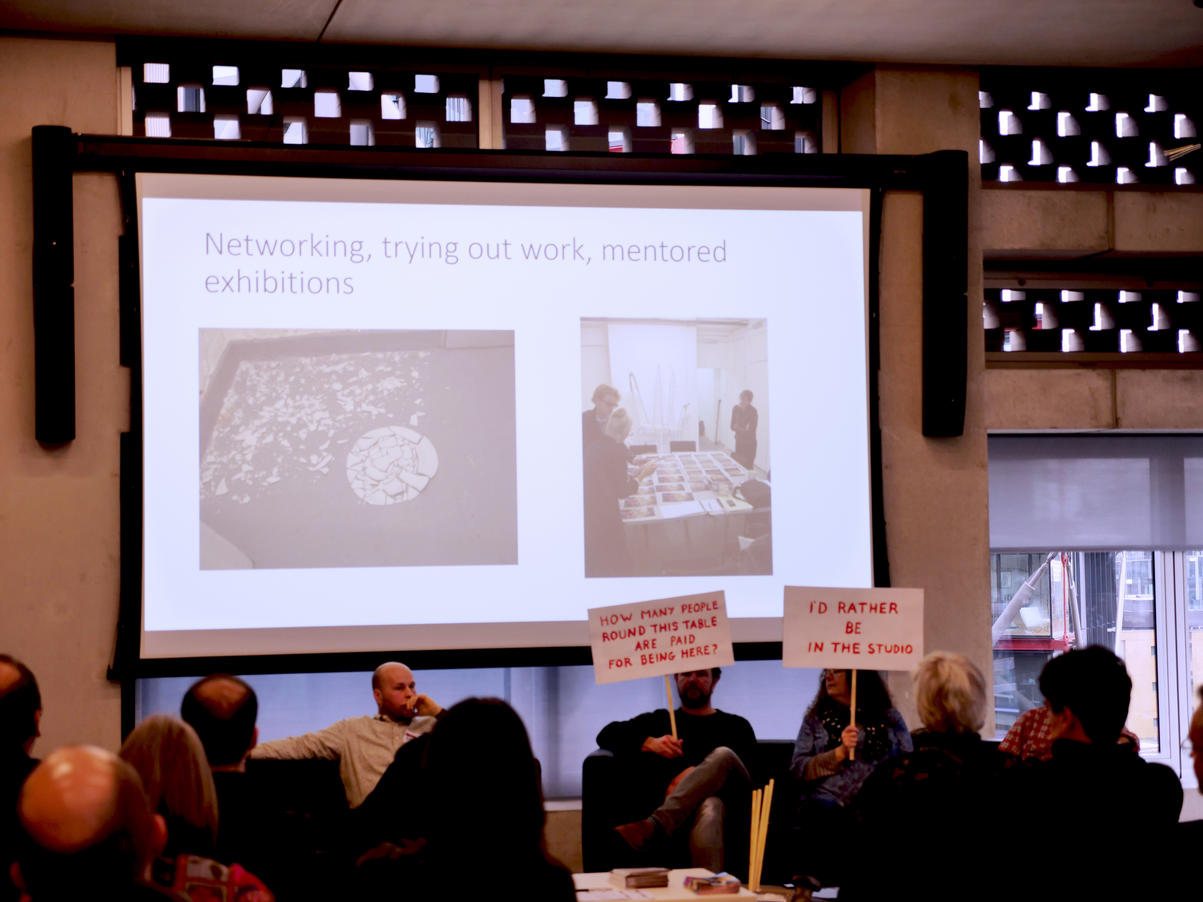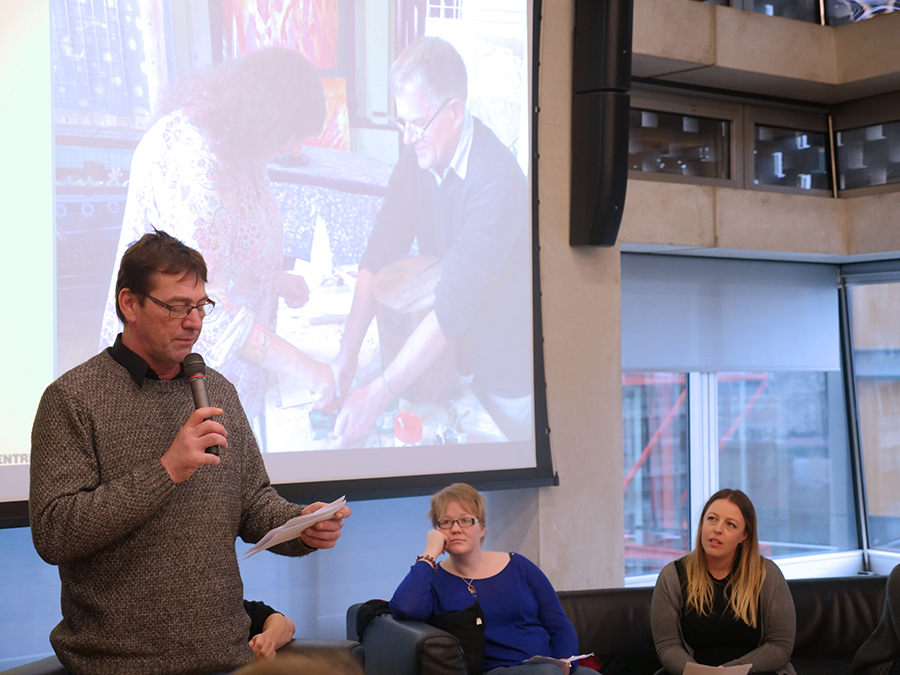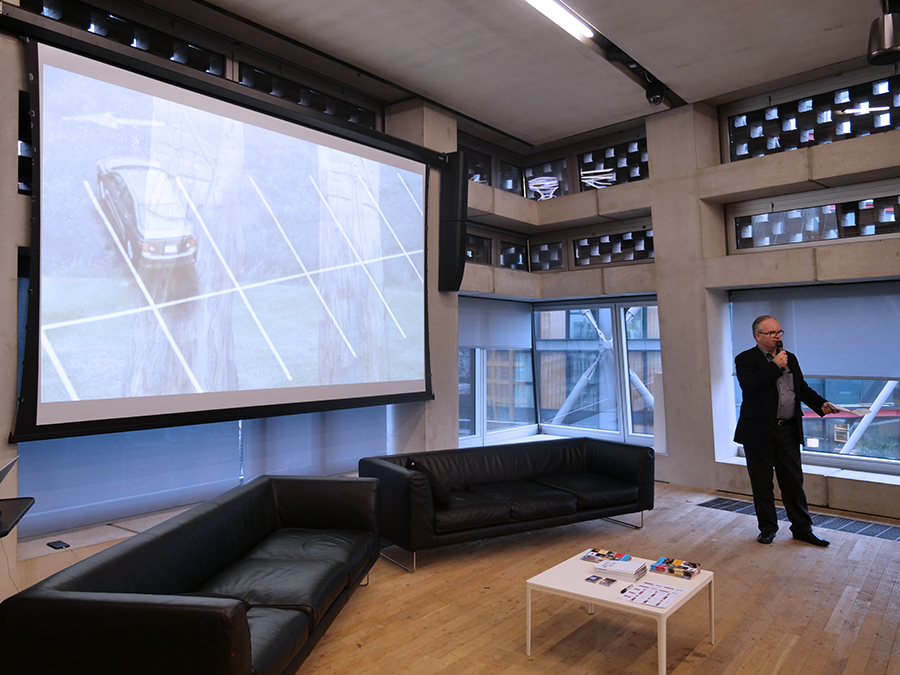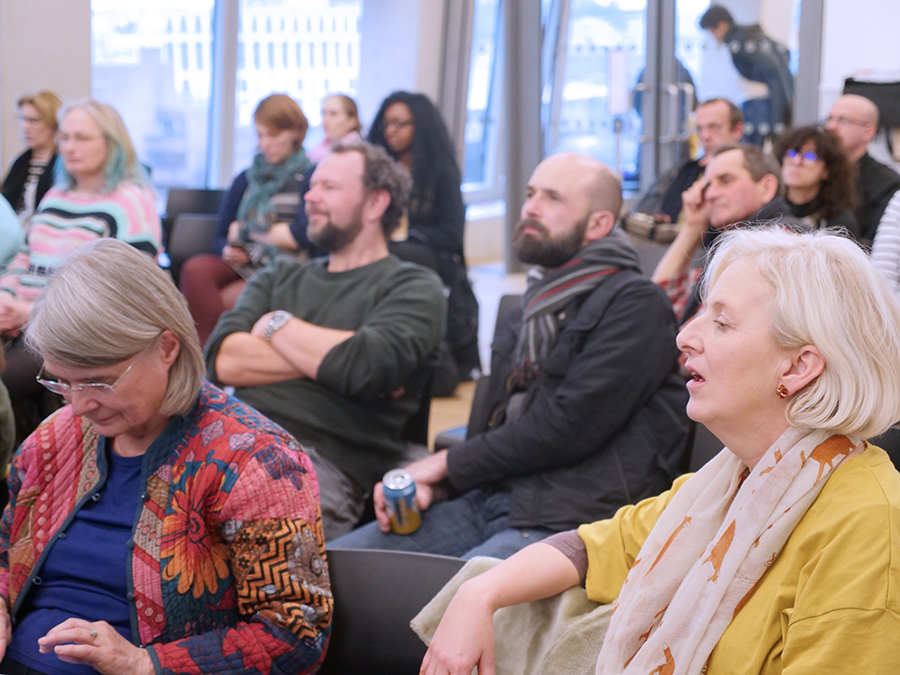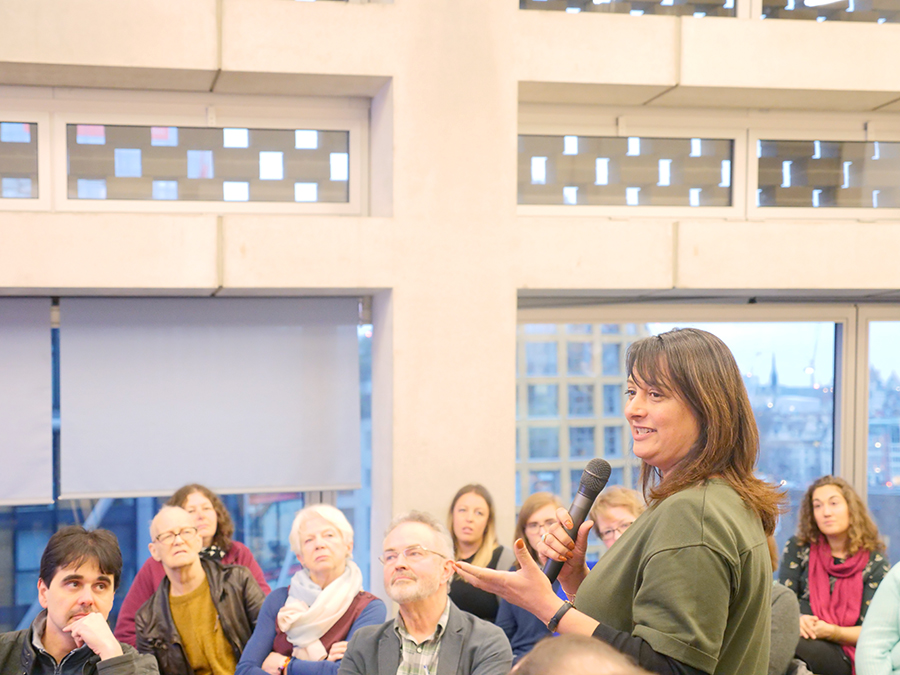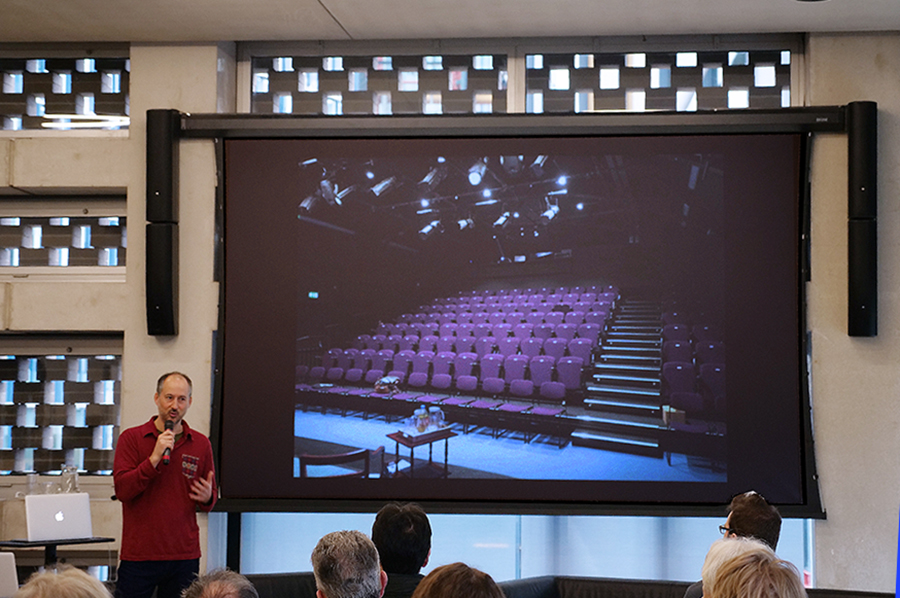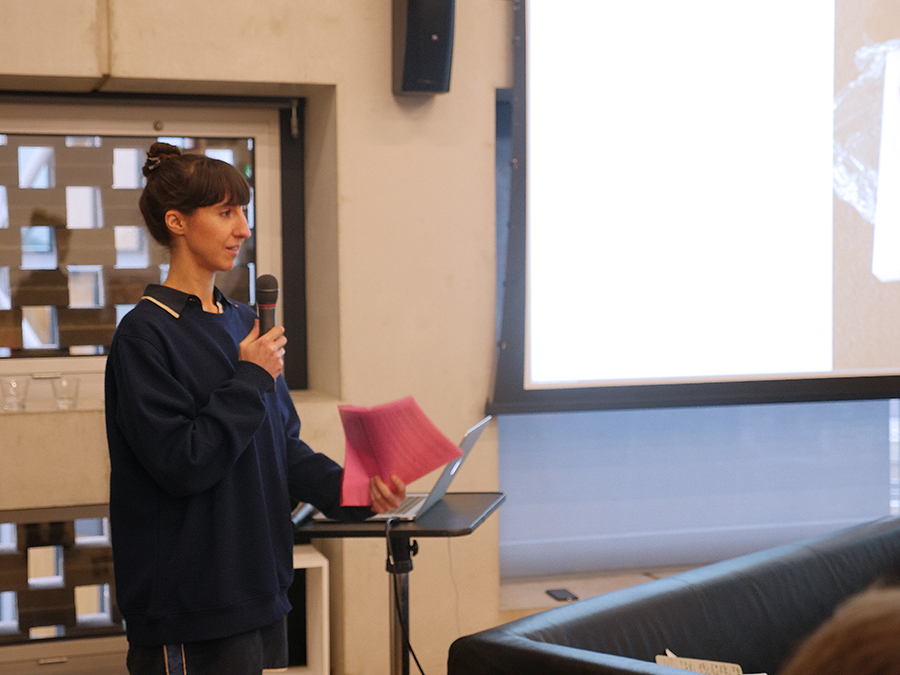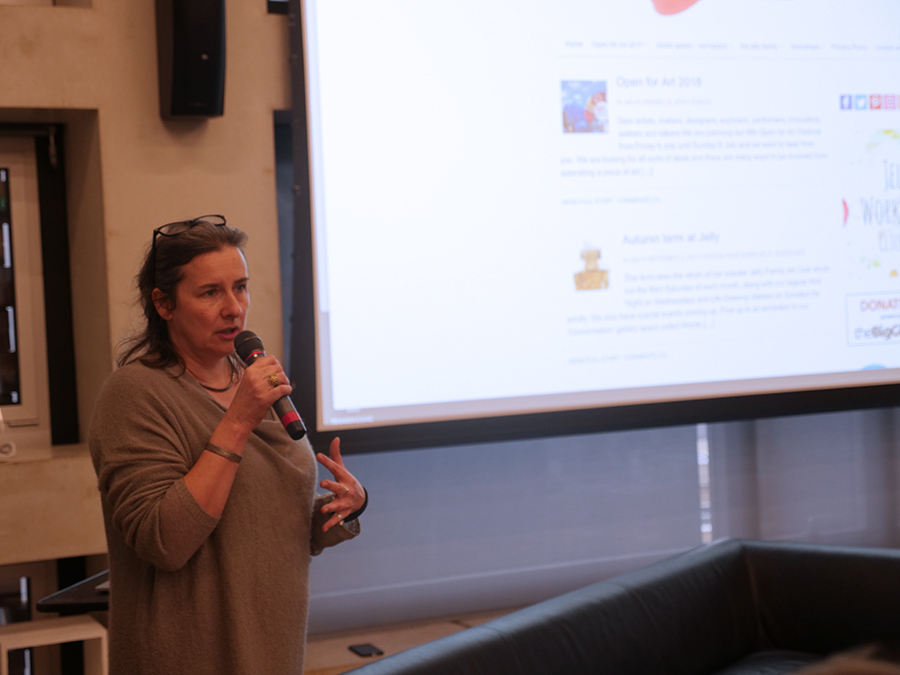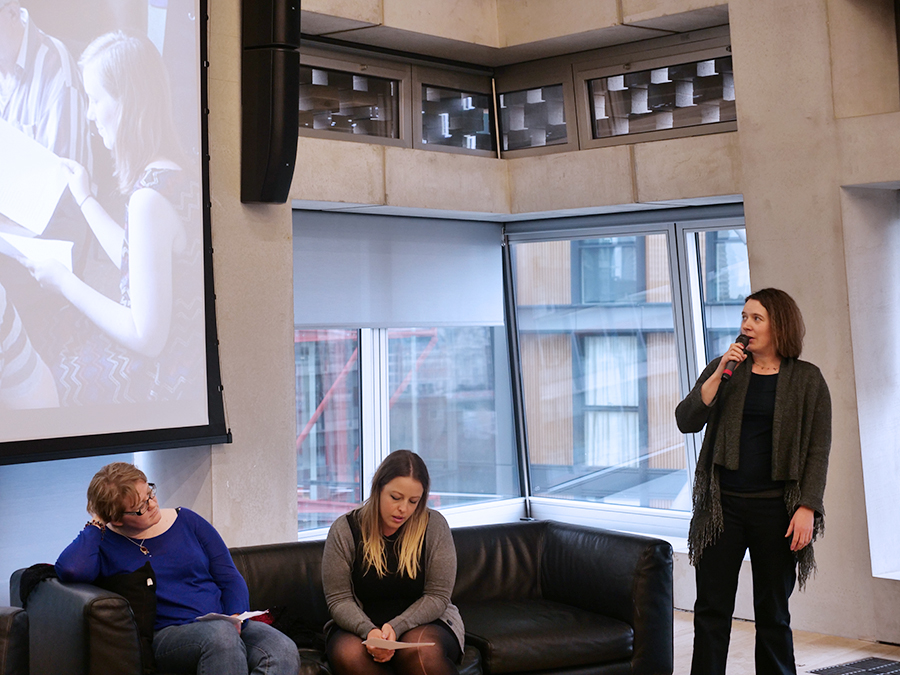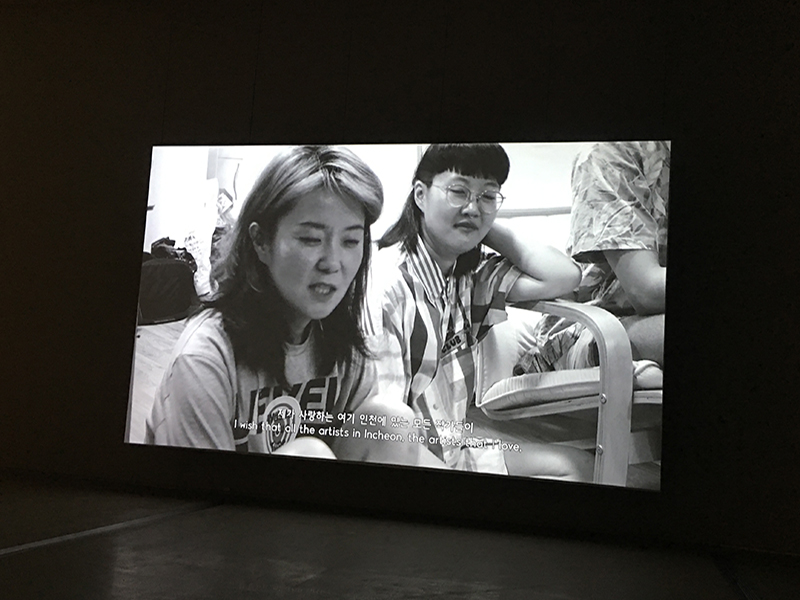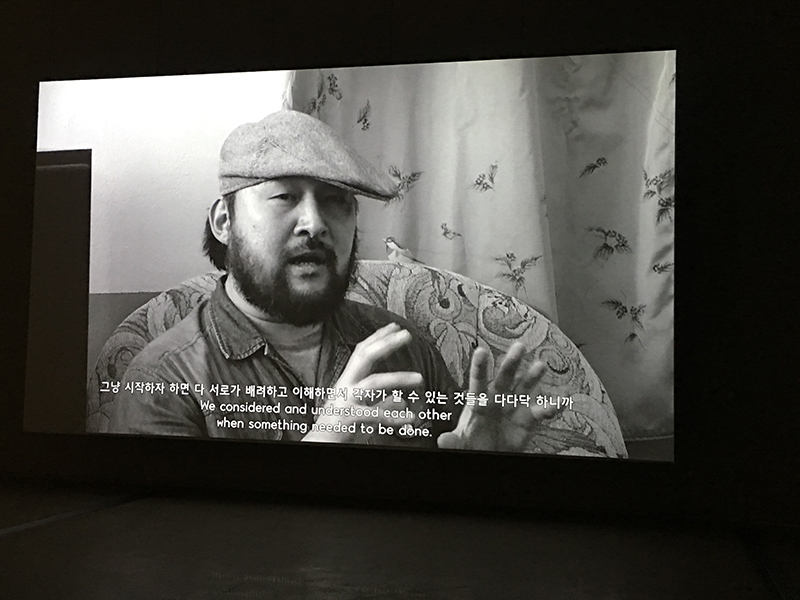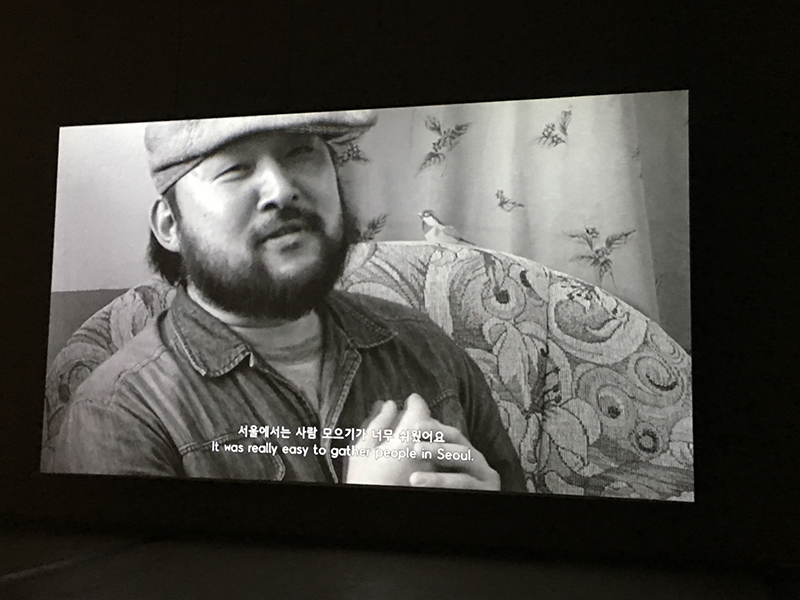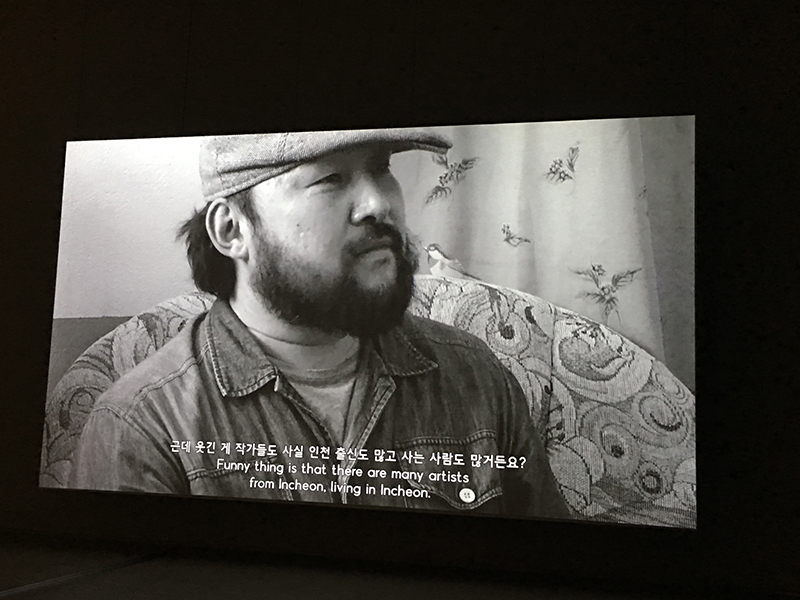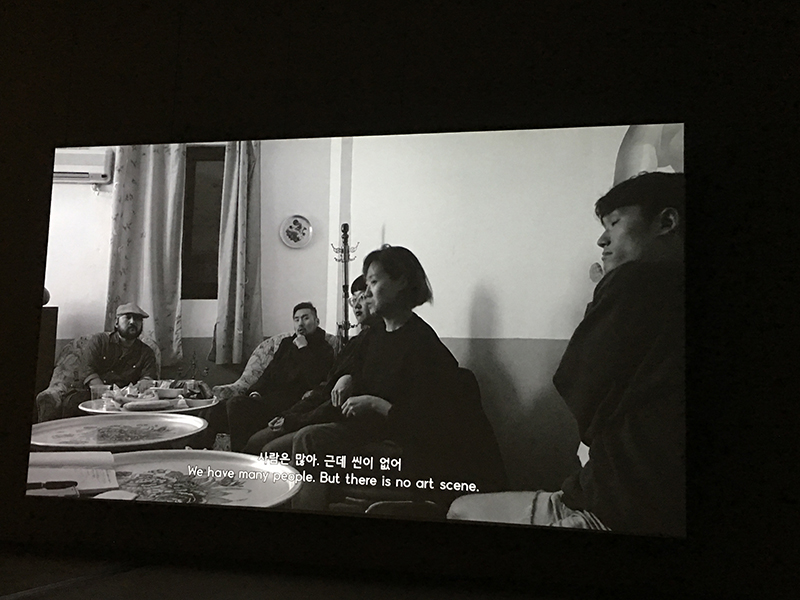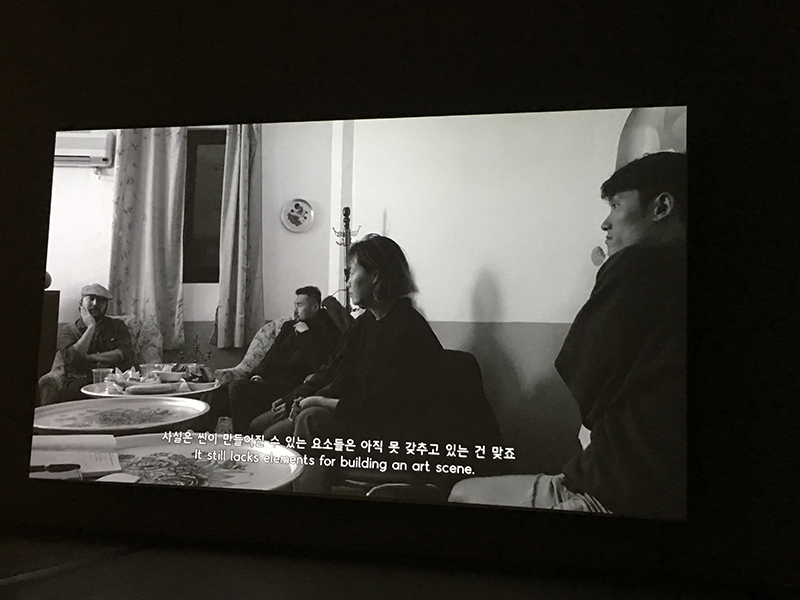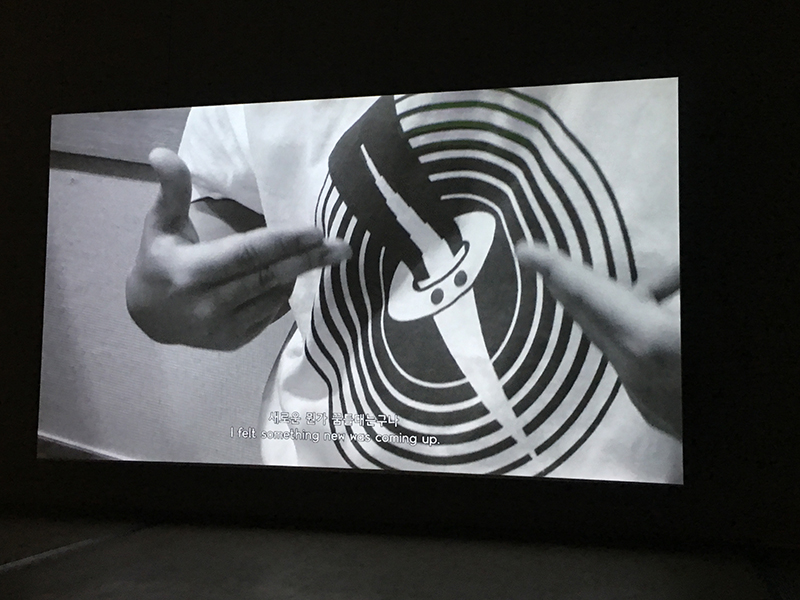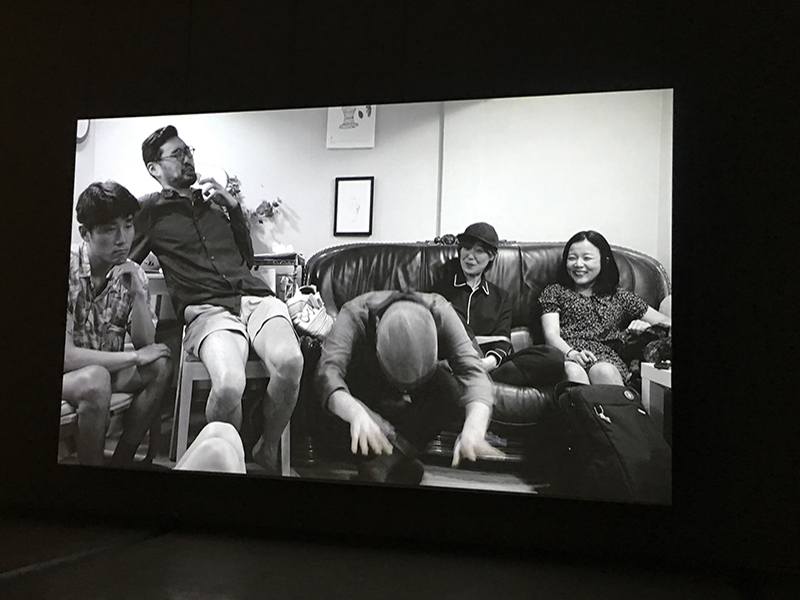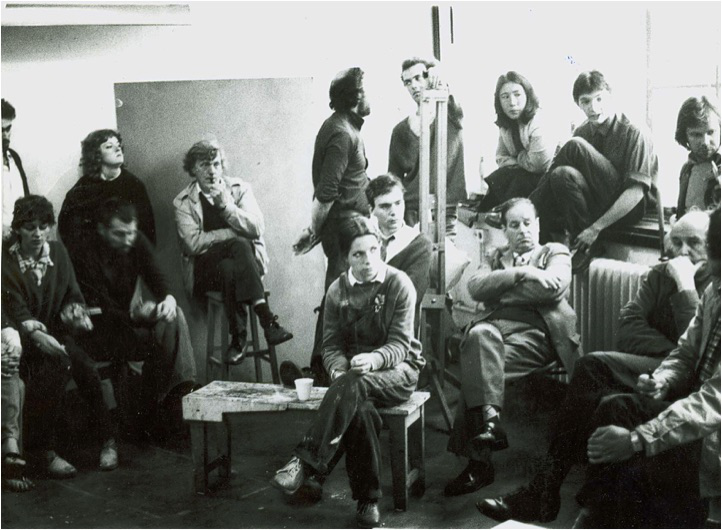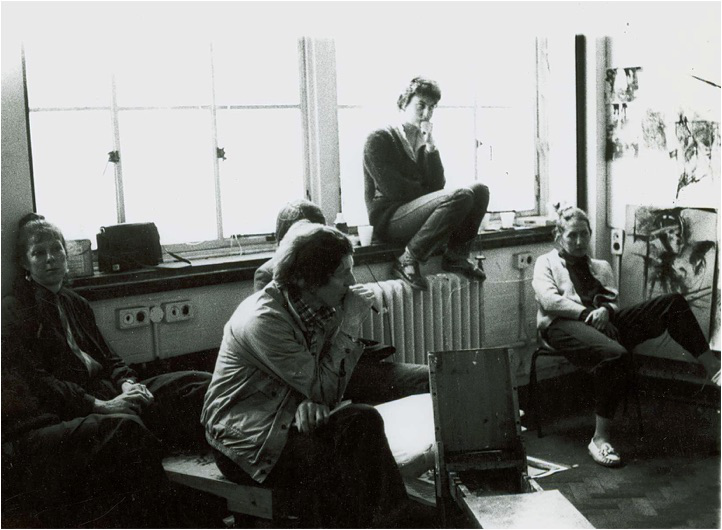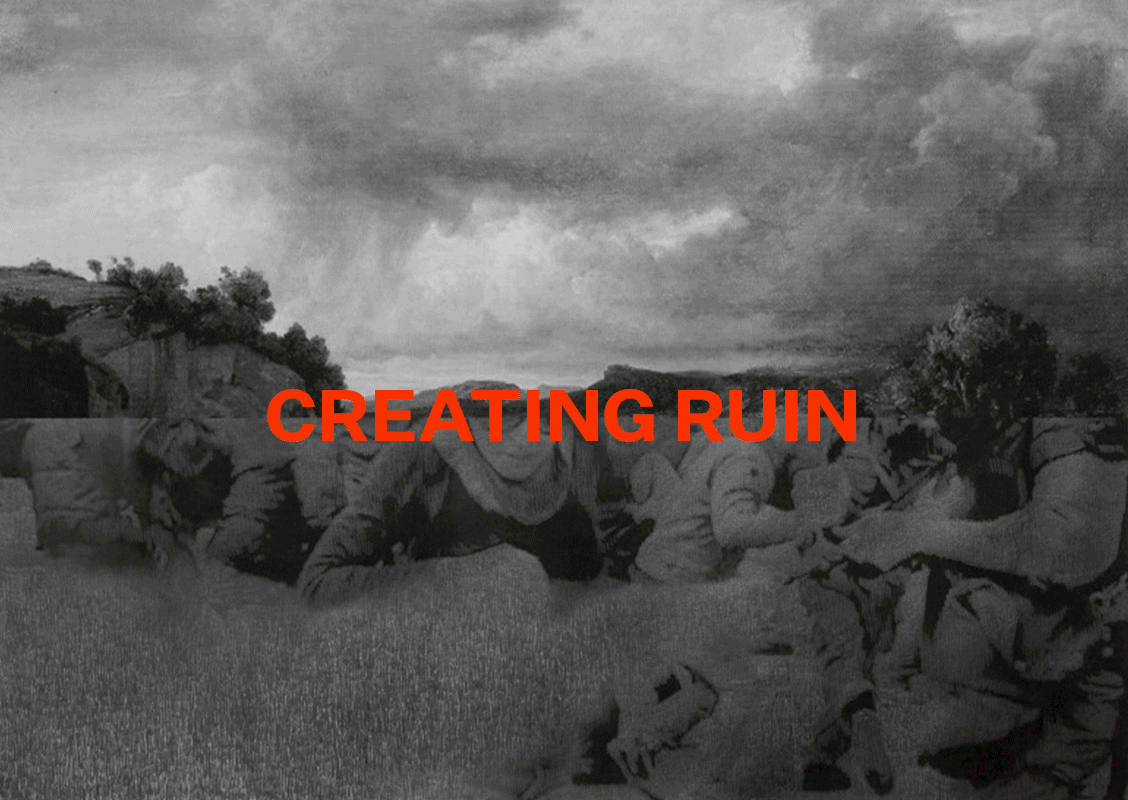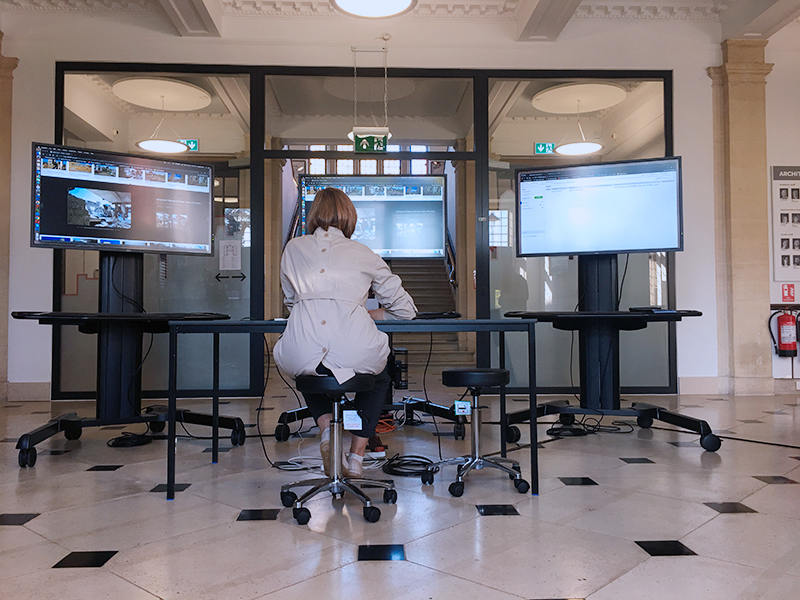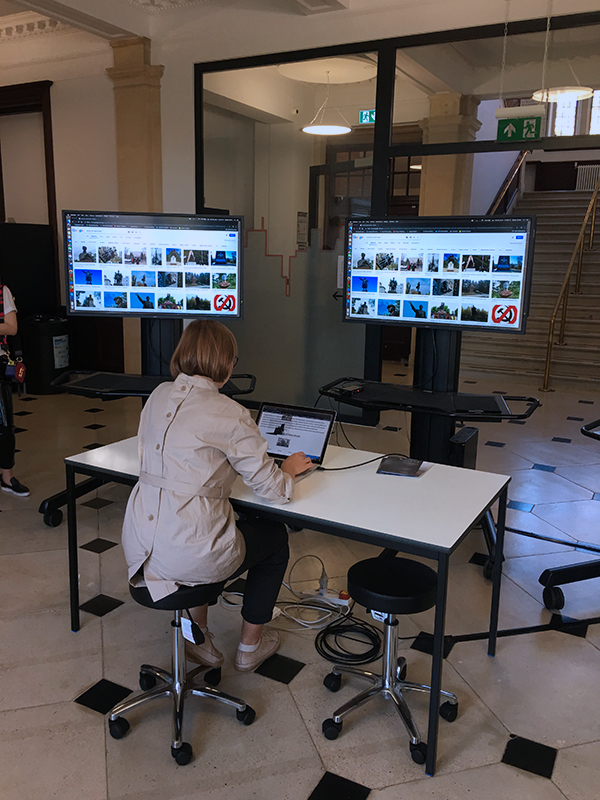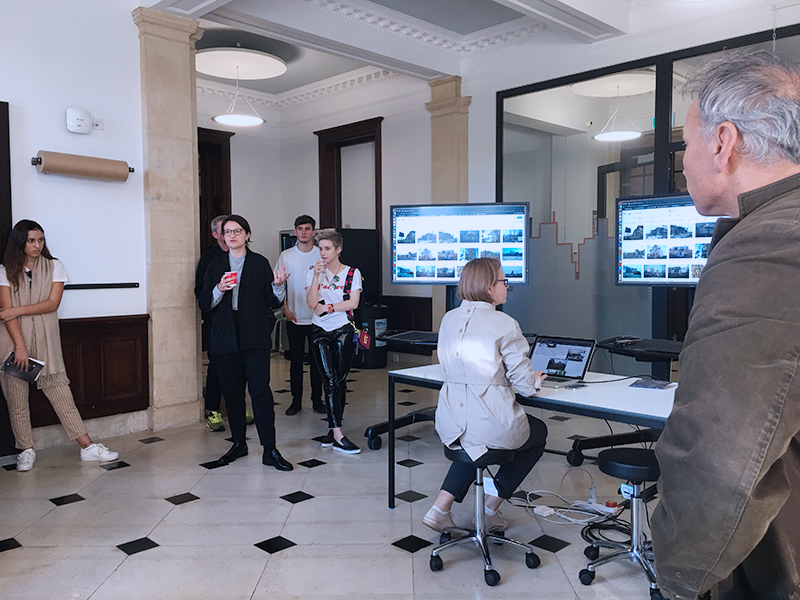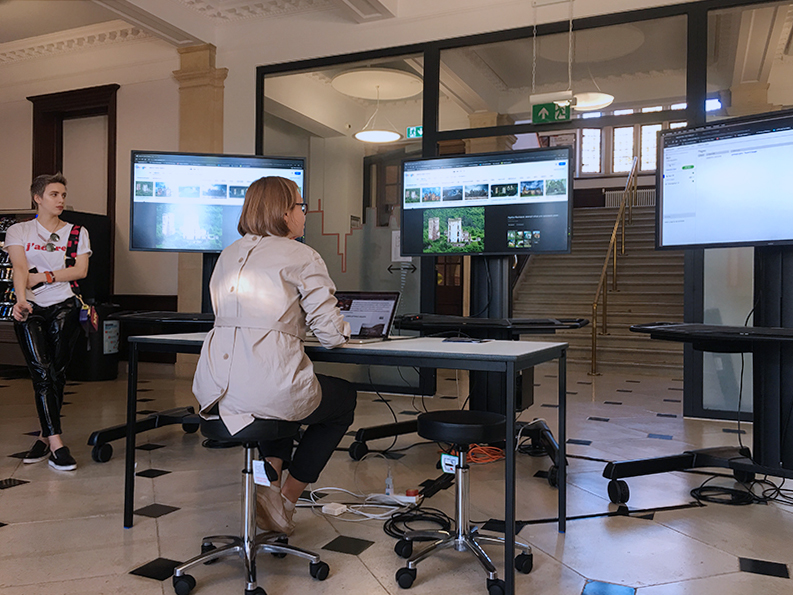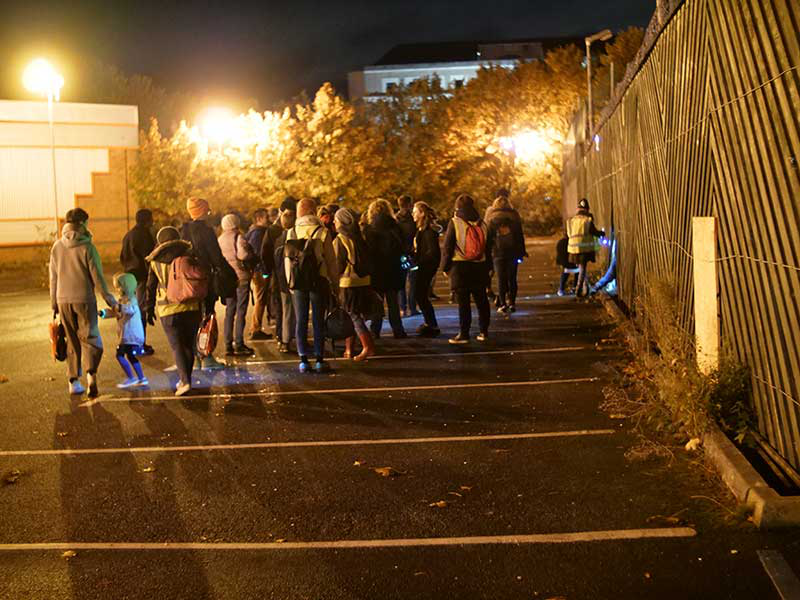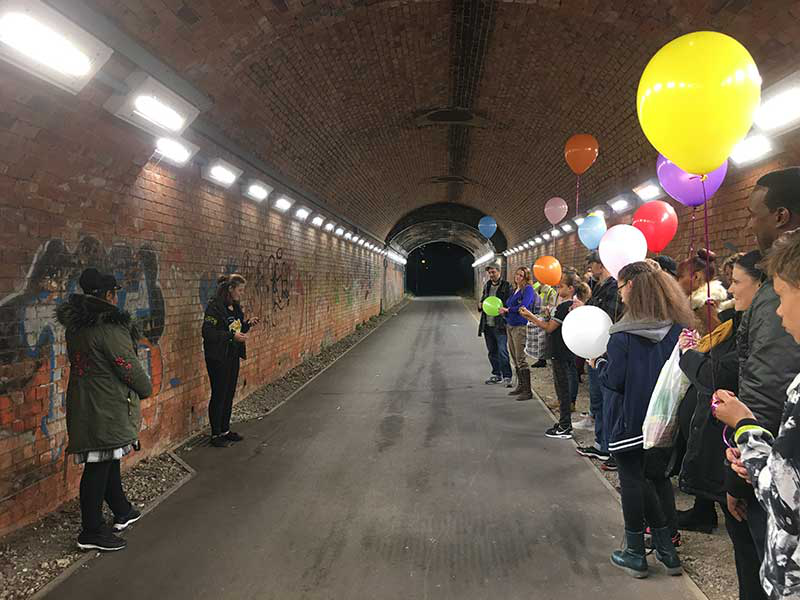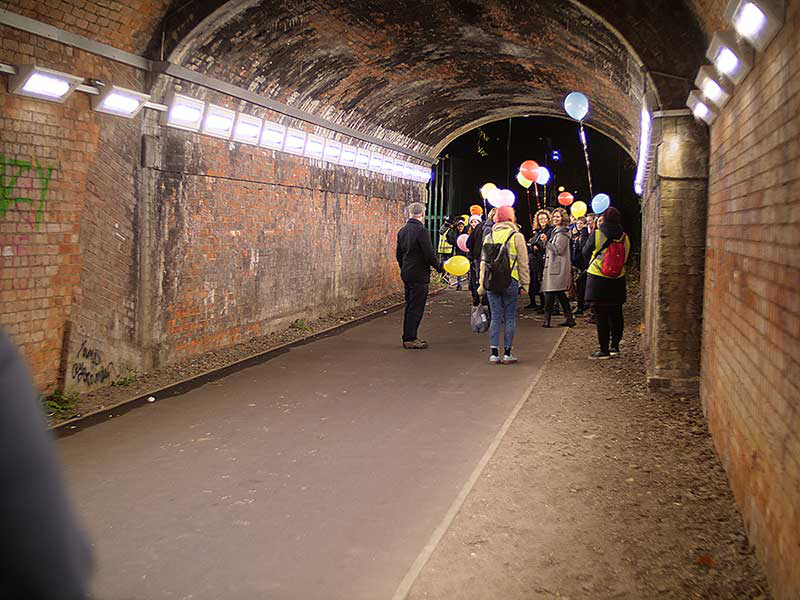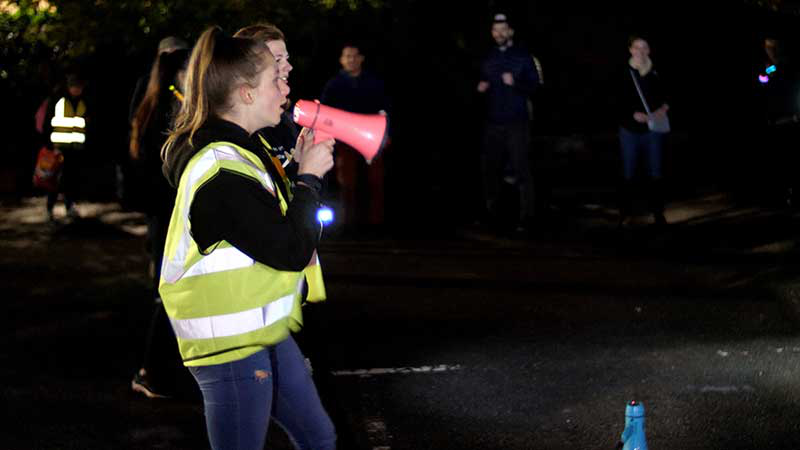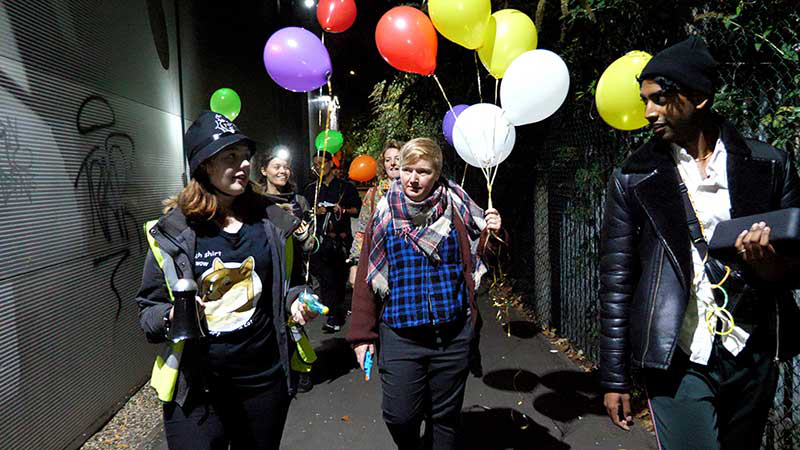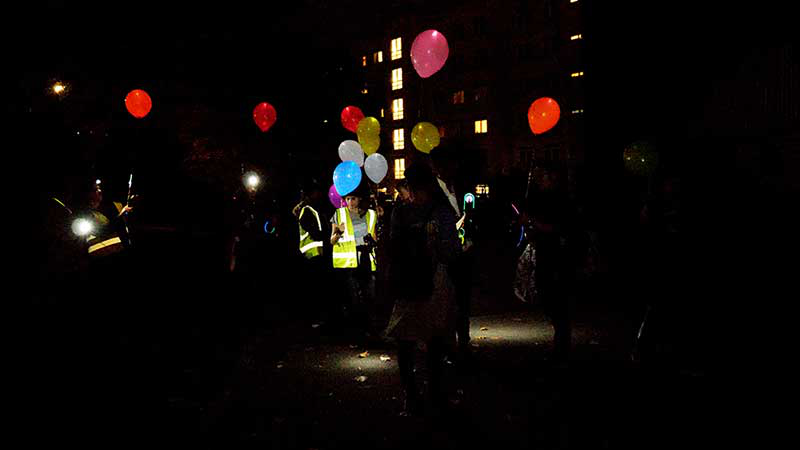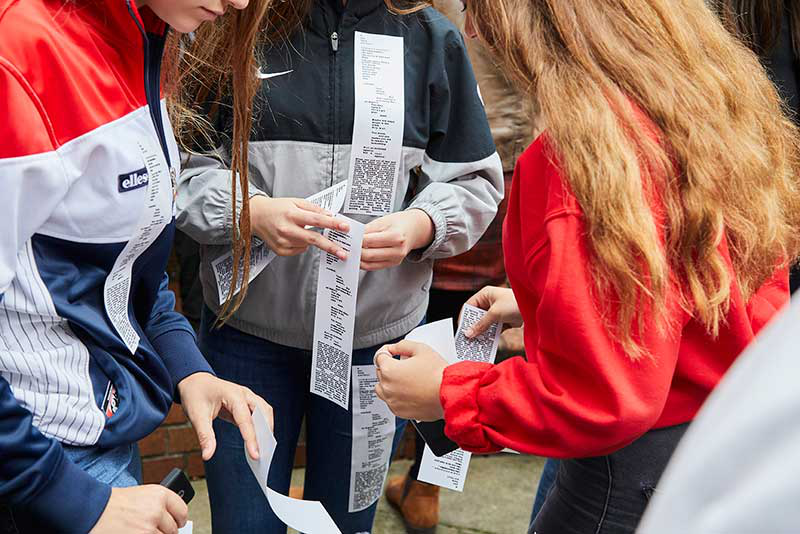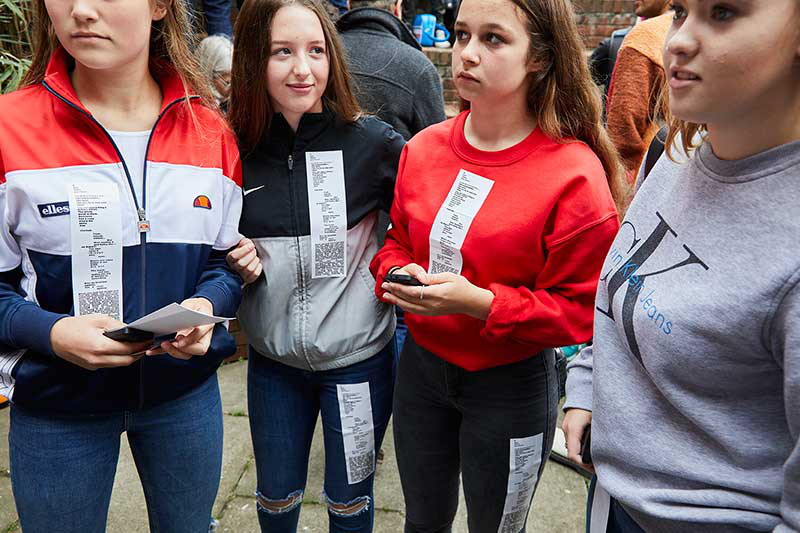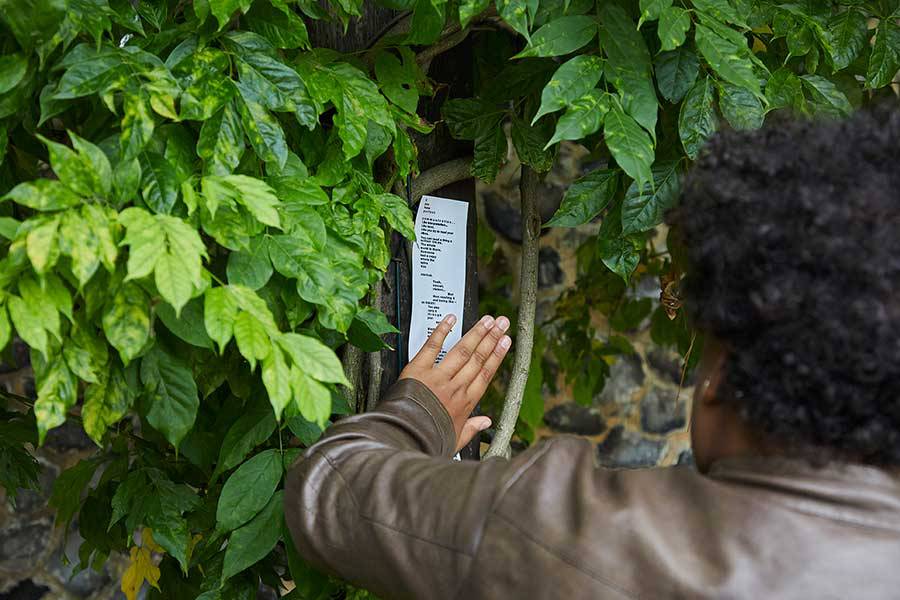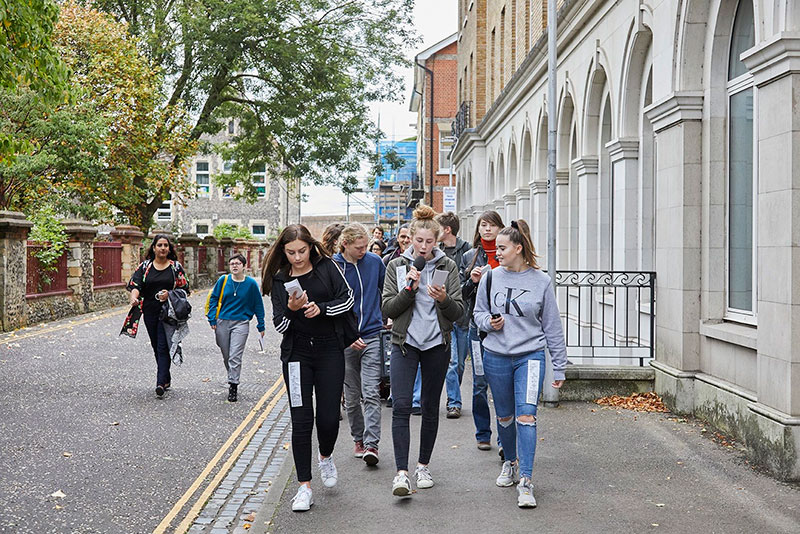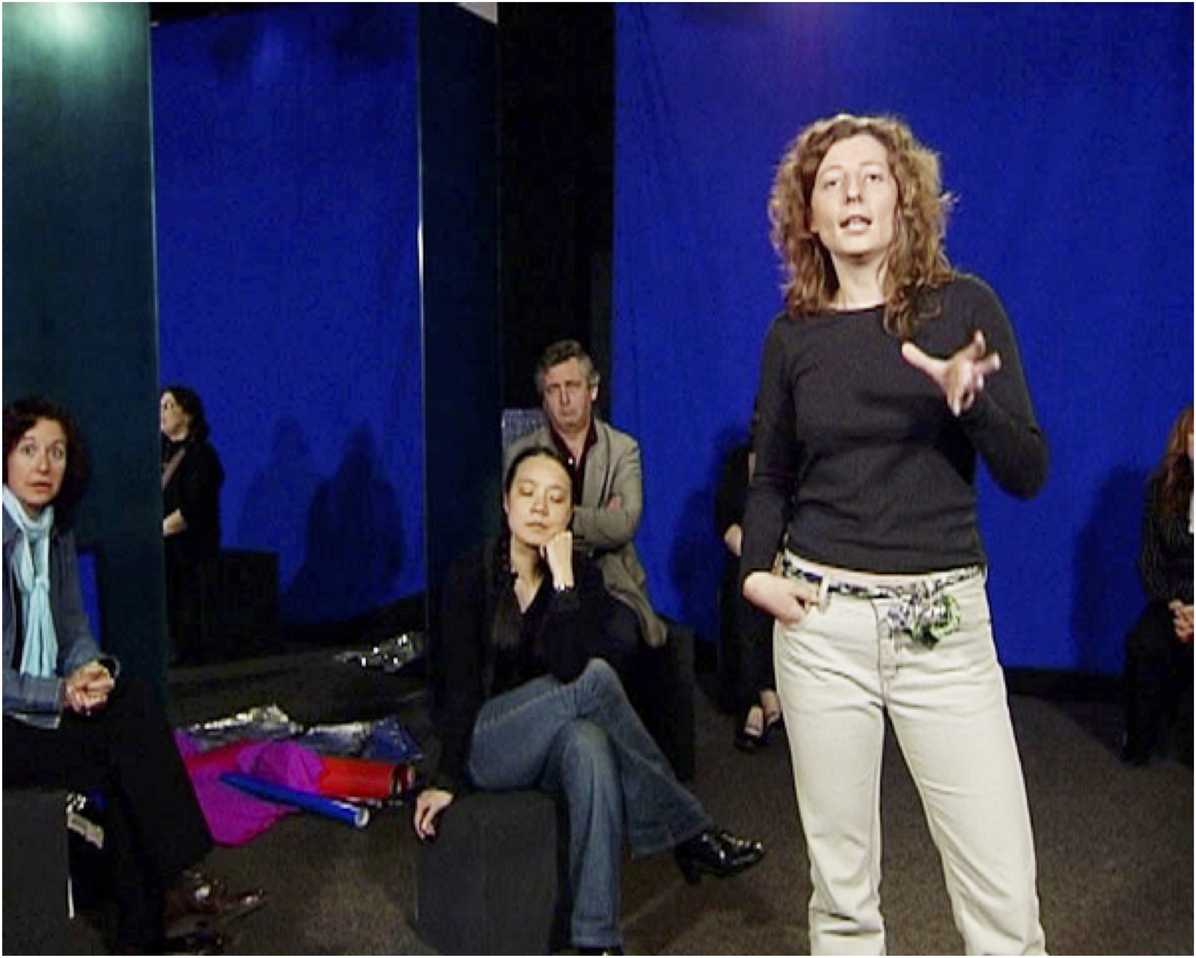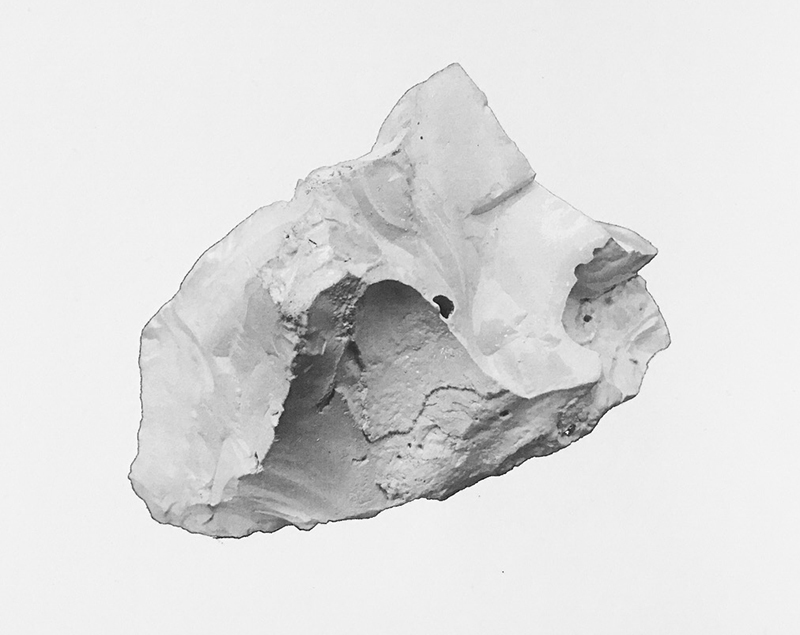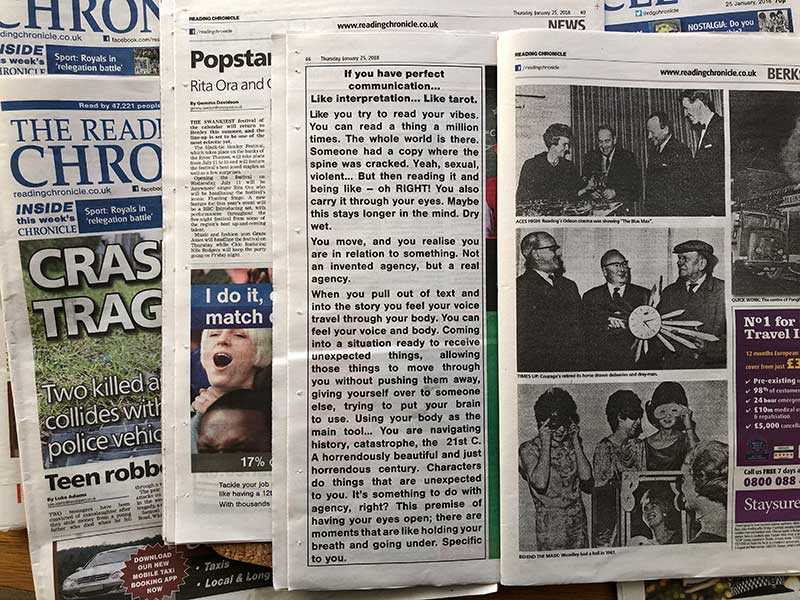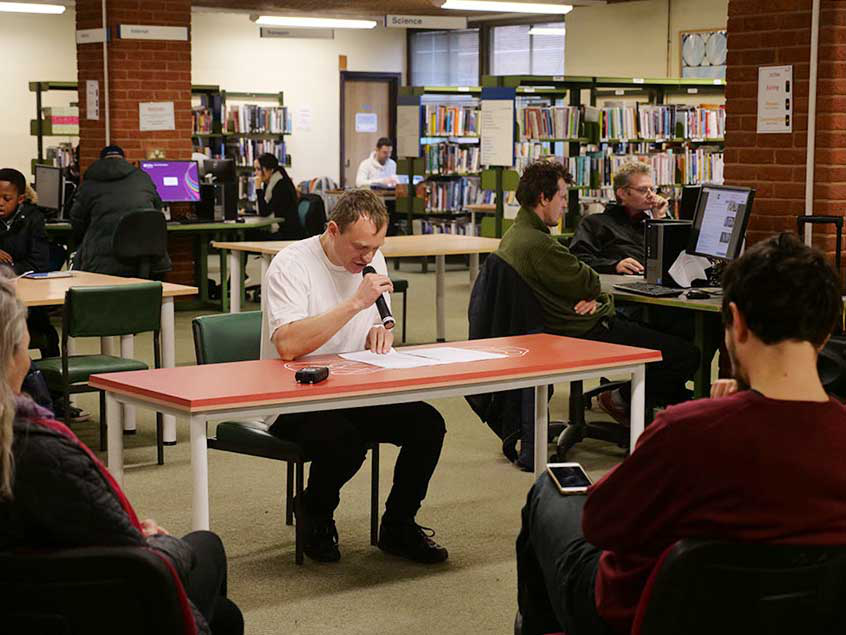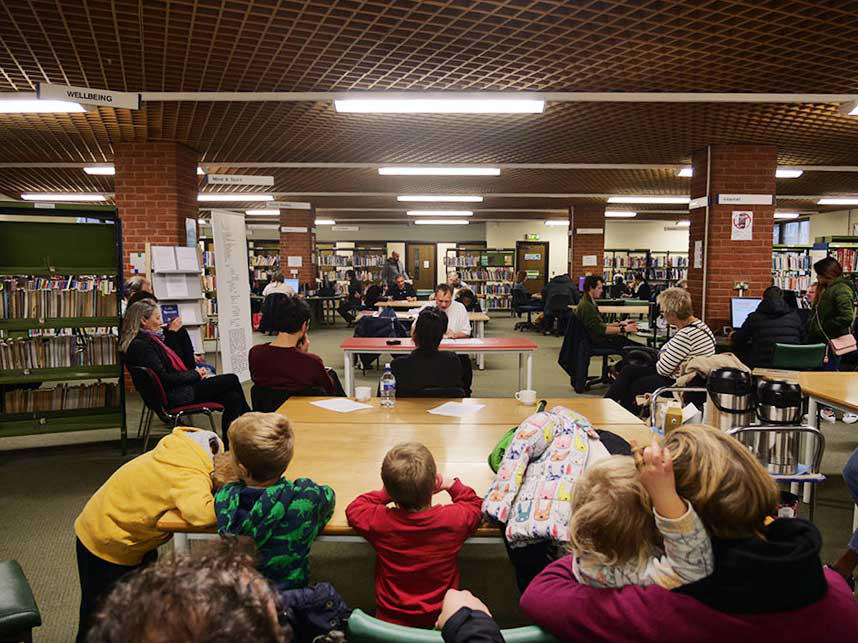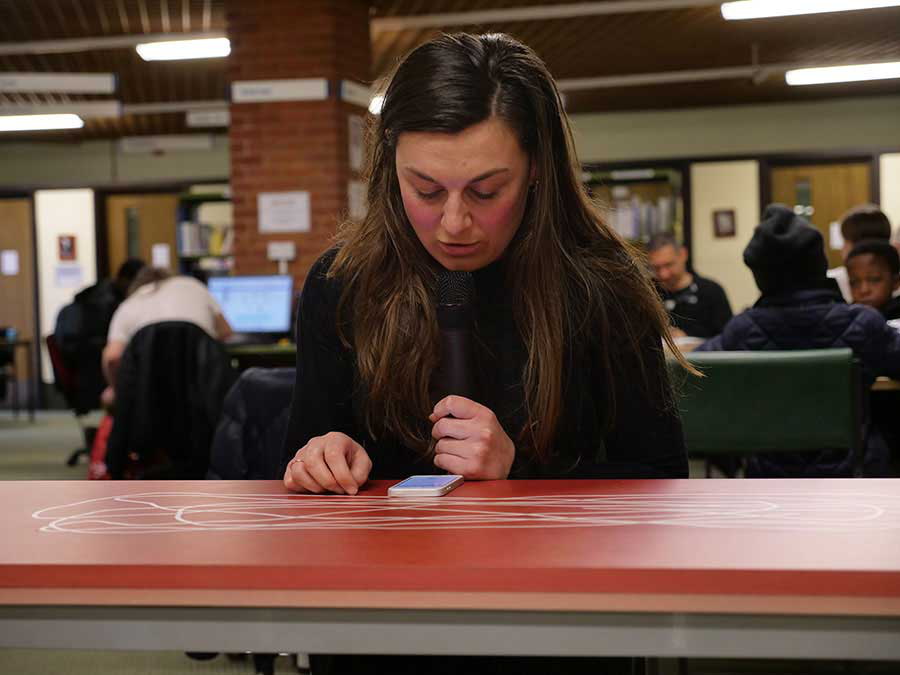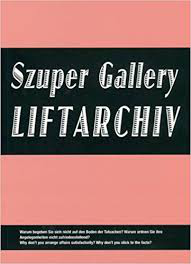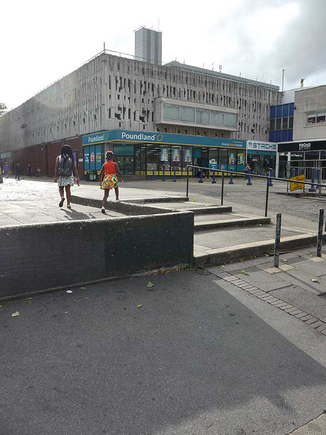Curating the Art School – Propositions for developing a collaborative art space in the intersection between art school and community
Susanne Clausen
1. The site-specific art school as a collaborative model
1.1. Szuper Gallery – Liftarchiv - Reading International
1.2. What can the art school offer the local art community?
2. What is going on in the art school?
3. Reading International: Curating the Art School
3.1. The Students’ Cultural Centre
3.2. A reproduction of three weeks in May 1970
3.3. Creating Ruin and Method Fund
This exposition presents the ongoing artistic research project ‘Curating the Art School – Propositions for developing a collaborative art space in the intersection between art school and community’ which has driven the creation of a new arts organisation at the University of Reading. I would like to offer an introduction to the research questions, a situational and theoretical background and present some of the artistic and curatorial explorations via photo documentation and links to the project pages as a running visual commentary on the right side of this exposition.
‘Reading International’ was established to develop and test the creation of a liminal space between an art school, a regional arts community and an international contemporary art network. By inviting artists to respond to the specific social and historical framework offered by the art school and the town the project aims to explore how we can imagine the art school in a university as a public arena, which opens its life beyond the academic community and actively engages with a wider public? Could the art school become a catalyst to create a speculative thinking space, erasing hierarchical (and economic) divisions between the educational environment and wider publics? How can we create a space that is less separated from the professional public, where artists collaborate with students and the community to create a dynamic cultural space in a regional environment? I would like to set out these questions at an interim stage of the project as a way to invite further responses and discussion.
1. Collaborative models
Reading International is a new contemporary art organisation located within the Reading School of Art at the University of Reading. It was founded and initiated in response to ongoing discussions with artists, academics, students and local arts organisations about how we might establish new models of working in education and to respond to the growing pressures experienced by students and young artists in connecting with the art market to generate a smooth entry into the successful triangle of academy – gallery – museum, and the increasing frustration of students to see future possibilities or career progressions within the so-called ‘art world’. At the same time it was an attempt to rationalise the existence of the art school within a regional environment, to find out if could act as a regional contemporary art hub or centre, and to explore its possibilities in connecting and engaging with the different rhythms of the local arts community, to interrelate and raise ambitions for its co-existence and future. Building on my experience in collaboration and self- institutionalisation (Szuper Gallery), in developing critical partnerships with challenging institutions (Liftarchive), working as an artist in a university I was interested in creating a new ‘container’, an idea for a space that could involve artists, students and community in order to make the art school more site-specific, and more useful for its members. I set off to imagine the art school in the university as a public arena, which opens its life beyond the academic community and actively engages with a wider public. Could the art school become a catalyst to create a speculative thinking space, erasing hierarchical and monetary divisions between the educational environment and the wider public? How can we create a space that is less separated from the professional public, where artists collaborate with students and the community to create a dynamic cultural space in a regional environment? What groups and partners should we invite? What would a model for such a public space look like? What are the challenges? How can we conceive of curating the university to the benefit of both students and those outside of the university? What is at stake in this collaborative effort?
This exposition sets out the wider framework that drives the creative processes that guide the work with artists and partners and introduces some its results. I am intentionally positioning this project within the context of artistic research, as it is my explicit experience as an artist working in and with a number of collaborative formats and within an educational framework that drives this projects. After introducing a series of examples as case small studies I will reflect on outcomes and challenges to examine what we have learned in the process and how our findings might contribute to wider framework of discussion on collaboration in and through art education?
1.1. Szuper Gallery – Liftarchiv - Reading International
Why is everybody always talking about collaboration? In his latest book Mark Terkessidis focuses on the imperatives of collaboration, co-operation, and self-organisation, which, as he outlines, are ubiquitous not only in the entrepreneurial sector, but also in today’s cultural institutions, state agencies or businesses.[1] Starting from an argument on a pointed critique of the institutional pitfalls of Germany’s ‘integration debate’, Terkessidis looks at how concepts like participation and self-organisation could promise a sense of renewed democratisation for working in and with institutions, and how this could connect not only to politics but also art practice. He explains how although the imperative to collaborate originates in the neoliberal tendency for governments to shift their responsibilities onto the individual and onto communities, he believes that a new approach to collaboration could also trigger a genuine will to create something together, and that the ensuing opportunities actually have the potential to open up new spaces.
When I was an art student in the late 1990s there were no courses, lectures or other teaching sessions on ‘professional practice’ or creative entrepreneurship. It became clear rather quickly that self-initiative was the only workable way forward, and so there was a need to appropriate, to pretend, or even to pose as ‘professionals’. In doing so we also always tried to subvert our understanding of what ‘professionalism’ actually meant. The 1990s across Europe saw numerous artists’ groups and projects institute themselves. On graduation from the Munich Academy of Fine Art I was offered the opportunity to take over a commercial gallery (Szuper Gallery), working collaboratively with two other artists, as the gallery owner went into another business. With little experience of the commercial world, and as new collaborators, we started the curious project of managing the gallery, which had originally been dealing in contemporary art from the Ukraine and former Soviet Union. It seemed the obvious challenge to us that we had to take on this format as a conceptual project in itself and so we started running Szuper Gallery as a tool to develop the formal vocabularies of a commercial gallery, to extend and define the concept of ‘gallery’ as a form of institutional critique. The gallery went bankrupt not only because we were not focusing on selling art works but because we turned the running of the gallery into a performance of itself. We staged private views as performance events, we performed our gallery sponsors as exhibits, and we curated exhibitions and worked with artists who were equally questioning the frame of a commercial gallery in interesting and challenging ways. When the commercial enterprise broke down, we appropriated the name ‘Szuper Gallery’ as an umbrella for our future collaborative activities.
Since then Szuper Gallery has continued to be a useful device for an artistic strategy that has enabled me to take on different roles and personas, of artist, curator, producer, gallerist and educator, and I have since used it for different interventions and collaborations. These turned out to be mainly different institutions, places of work or authority, or whoever would employ us or pay for working with me and my collaborators. Each of these ensuing collaborations with artists and institutions carried with them different structures and challenges around questions of collaboration, authorship or partnership.
The Liftarchive is one the collaborations that Szuper Gallery undertook with a local authority institution, commissioned by ‘Quivid’[2], the public art programme run by the city of Munich under the umbrella of the Department of Public Construction of the City of Munich.[3] The Liftarchive is a permanent site-specific installation. It was installed in Munich’s Immigration and Registry Office and is comprised of a glass container installed at a height of eight metres’ on a movable, hydraulic platform. The container mimicked the ‘white cube’ of the gallery space, fully transparent, yet separated from the institution by its height and by its glass walls. This container travelled up and down the wall of the government office, and was opened to the public at regular intervals. Situated within the context of the immigration office it performed the functions of a living archive, building content by hosting a series of interventions and projects by different artists, who on our invitation responded to the context of the administration of immigration in different, and sometimes difficult ways. The Liftarchive referred itself to the institution, but offered no release from its content or challenges. It was successful as a provocation of a self-contained art space, but it was also a catalyst for conversation and debate. Over the course of the two years of programming it became increasingly clear that the space that it had occupied as an artwork was located in the somewhat liminal space of co-operation that had opened up between the hosting institution and the artists, its complicated guests.[4]
The question of what collaboration could mean in an art school remains pertinent. For the video project ‘The strength of the system, my experiences of it, was that in fact, oddly enough, it was actually a very collaborative enterprise already’ (Video, 30 mins, DVD, 2006). I conducted an interview study with different artists questioning their understanding of collaborative processes in teaching[5]. From this material I produced a video work, for which I re-enacted the original interviews with the help of a group of both professional and amateur actors. These actors can be seen in a recording studio, grouped in a situation that resembles a seminar or studio set-up,re-performing the interview scripts by reading them off an auto-cue, and thereby engaging in different moments of collaboration themselves. What I found in the interview process was that the respondents saw similar working strategies or parallels between creative processes and teaching situations, and they identified moments of co-authorship and collaborative processes. I identified several professional and collaborative models. These included the ‘invisible teacher’ who creates art-life-education crossovers, where teaching involves spending time together. Another model was that of the art lecturer as ‘director’ who conducts the student team, similar to models of art production, creating situations that enable students to develop work in a collaborative situation. A further model emerged of the art lecturer as ‘midwife’ as a metaphor for a caring role, supporting the student ‘giving birth’ to new ideas, sharing moments of creation. These descriptions already open up obvious connections to ‘curatorial’ strategies that might equally involve strategies of caring, directing, socialising, and so on, as a way to describe the process of collaboration between artists and curators.
Reading International presented itself as an opportunity to create a new device, and as a way to co-operate with different artists, curators, educators and host partners within the institutional framework of the university, and thereby invent a new place that could fill the gap of a missing, but much needed, contemporary art space in the town and the university. This need was also identified by the Arts Council of England in their survey of regional arts activities across the UK, who identified the area around the university as a ‘grey zone’ in funding terms, and a funding partnership of the Arts Council, the University and the local authority was established relatively quickly.
The projects developed so far do not have an overarching theme, other than that I decided to work with different artists or curators who were invited to respond to a specific context of the town or the university and who were placed within a partner enterprise. The basis for the partnership with the local hosts was not to attempt to offer a directly collaborative process with host partners, or pretend to be within the realm of a socially engaged community arts framework. The projects have not been intended to directly fulfil any tasks that communities might have asked for. Instead it was agreed partners would provide us with the container and allow us, in this case the artists, curators and students, to fill it with new content and new propositions for interpretation. This strategy is similar to that of Liftarchive, in that it brings with it an interesting clash of ideas and new visions. It is also an opportunity for different constituents of the university, the town and the international art community to meet and to interact, facilitated by a programme of talks, events and workshops. By embedding students in all parts of the project, as artist assistants, technicians, workshop leaders, exhibition guides, and interviewers, we might be able to argue that the art school has invented a new way of delivering professional practice by immersion. And what had been encouraging throughout is that our hosts have trusted us with this process. The challenges that have arisen are those that come with all forms of collaboration, and are what continue to drive the conversation.
The first project ‘All Day Breakfast’[6] was curated by artists Matt Copson and Alastair MacKinven for Munchees, a small Nepalese café in Reading town centre, where they installed thirty paintings by different international artists. The show took on the format of ‘coffee shop exhibition’, in an unlikely venue. Following projects were hosted by central Reading office tower block, a local community arts charity, the local history museum, the Museum of English Rural Life, a community arts centre, the university’s Great Hall, billboards, hoardings, and others.
1.2. What can the art school offer the local art community?
Reading is a commuter town and digital industries hub situated 30 minutes away from London by train’. It has a small number of long-standing community arts organisations, whose focus is to support its local base of artists, most of whom struggle to make a living within the arts. The town has two museums with a decidedly local and historical focus, but the cultural community agrees that it lacks a more international contemporary art gallery. The local arts economy is fundamentally based on a large community of volunteers who are willing to give their free time to organise cultural events and activities in the town. Like in many regional towns there are numerous artists and cultural workers who find themselves based outside the typical art centres for a number of different reasons. Some stayed in the town after graduating from the art school, others moved here with family, or have been here all their lives. There is local pride for local activities but there is no ‘art scene’ and there is no art industry for its workers to benefit from. At a recent Tate Exchange event, to which we invited all small Reading based arts organisations, one of the audience members asked how many of those present had actually been paid to be at the event, and only three of 70 people raised their hands. This low number is indicative of the situation. There is big enthusiasm in towns like Reading to create an exciting cultural offer, but resources and professional structures are slim. Although this is not a rare situation for communities of artists generally, in the regional context it limits participation on a more professional level to those people who are either hugely enthusiastic or those who can afford to give their time for free to organise cultural events. In addition, this also limits the scope and scale of activities and sometimes it makes it harder for those volunteering to look outside and embrace more ambitious opportunities. And so whereas the art system has become a large operating machine in most capital cities continually in need of need of skilled and educated labour to create and deliver content, this has yet to develop in some of the regions.
The volunteer culture also puts even more pressure on the community of art graduates, who have already accumulated enormous debts throughout their studies, and who at the same time are also encouraged to seek as many internship and volunteering opportunities as possible to increase their employability prospects. In some ways, the volunteer culture benefits the regional arts economy, but conversely there is also there is a defined lack of economic opportunities for younger artists in the regional environment and so few will remain in the town. There is a need to create more opportunities and spaces for younger artists to enable them to stay in the region after finishing their degree and to encourage them to contribute to the local arts community and hopefully establish some of their own infrastructures. Gregory Sholette has examined artists’ working conditions and the power of the market using the cosmological term of Dark Matter, referring to the mass of non-reflective particles emitted via the Big Bang which are invisible and yet are estimated to make up most of the universe. Sholette argues for a way of thinking that allows for those who claim to make ‘art’ to define it on their own terms, and examines how these self-defined cultural practices operate within a changing economy. He considers what he calls the ‘structural darkness’ within which most professionally trained artists appear to exist, those who do not make it to the elusive light of stardom or commercial success, but who operate through other kinds of economies consisting of often informal or micro-institutions, and a variety of activities which are based on volunteer work, on pleasure, and on the free dispersal of goods and services, all of which are activities that focus on accessibility and wider reach.
It is also comprised of all those artists working as educators in art schools and universities, as art fabricators and art installers, but also includes the world of independent activities, small art collectives, as well as hobby artists, community art workers, teachers and so on. These ’create work that infiltrates high schools, flea markets, public squares, corporate websites, city streets, housing projects, and local political machines in ways that do not set out to recover a specific meaning or use-value for art world discourse or private interests’.[7] While recognising the limitations, Sholette explores new ways to articulate the politics of the many who operate around the edges of the few in the spotlight and outlines how the divisions between the ‘dark’ and ‘bright’ sides are almost arbitrary, independent of education, talent, or other qualities assigned to the elites. He argues that these practice and their formations are key for the construction of another or counter-public sphere and advocates ‘for the opening up of this sphere and a re-orientation away from a preoccupation of representation, towards and articulations of the invisible’.[8]
‘What then is a School?’ asks Raqs Media Collective: ‘Is school a place, an institution, a set of facilities, a situation, a circumstance, an attitude or a constellation of relationships of the transfer of acquired, invented and accumulated knowledge, experience, insight from one generation to another’.[9] How can we use the situation in an art school to explore thinking through and with artworks and exhibitions, and to use this process as a way to connect with the local community? How can we mobilize this community and recognise the interdependencies and possibilities that open up in the spaces between university, art school, artists and cultural organisations, which have the potential to reciprocally provide cultural benefits, and to initiate an important dialogue between the flow of information and resources?
By setting up an organisation within an educational institution we had hoped to provide a starting point, a way to help to bridge this gap, by developing a platform for discussion, for exposure and exhibition, and crucially for connection to a variety of artists working in the intersection of these fields, possibly animating a choreography between the different streams of people and ideas.
‘Why do we create communities and how they are maintained?’ asks South Korean artist group Okin Collective in their recent exhibition at the Museum of Modern and Contemporary Art in Seoul. Okin Collective sought out different communities in regional towns in South Korea, and talked with different cultural organisations about why they formed a community in their town, how this community and its members interact, and how these communities are maintained.[10] In their video work ‘In Search of How to Revolve, or Its Contrary’ (2018) they document discussions among a group of artists based in Incheon, a small port city located just outside the capital Seoul. These discussions were strangely reminiscent of the regional situation of our project in the United Kingdom. The conversation between these artists might seem trivial, but they point out what it is like living as an artist outside Seoul, in a country where so many things are centred around the capital. The interviewed artists named themselves metaphorically after the practice of ‘revolving’ or ‘rotating’, a movement central to Korean martial arts techniques, such as Taekwondo, which is notable for its rotating kicks, its flying, twirling and spinning movements. This rotational body movement in Taekwondo is a catalyst for the generating force aimed to increase the power and impact of the employed technique. It increases the power of the muscles significantly and is meant to improve self-esteem, confidence and power or radiance. This seemed a fitting metaphor for what might be needed for a community of artists who aim to develop a sense of presence in a regional location.
2. What is going on in the art school?
As artists and educators based in a university context we have had many discussions about the role of the art school and the university and the way we should shape or develop our activities. We observe the neoliberal education project and students who see themselves as consumers rather than active, responsible bodies, taking ownership of their education. Many of us are engaged in collaborative and curatorial work, setting up groups and spaces or publishing platforms alongside our educational work, and this narrative has often shaped our understanding of teaching as an interface. We have been looking for what new and emancipatory teaching and self-empowering learning might look like for artists in the university context.[11] As part of this exploration, we have sought to find new ways in which the university could be imagined as a public arena, a place which opens its life beyond the academic community.
As the so-called educational turn has become more pronounced, we have seen numerous self-organised art schools, free talks and workshop programmes spring up in the UK and around the world. The reasons for these are complex but in the UK they can certainly be attributed to escalating student fees, overall cuts to arts funding and university budgets, or the neoliberalisation of education itself. What is obvious from this trend is that many are looking for an art school to be more self-determined, flexible, small-scale and site-specific, and responsive to the local context.
Thierry de Duve outlined the development of Western art education via three historical models beginning with the Academy that focused on original talent, where learning was passed on from the Master artists to the teaching of a Métier, centred on the understanding of how genius, technique and imitation are constructed and developed, followed by the avant-garde schools, such as the Bauhaus, who focused on the nurturing of creativity and invention whereby the individual is located in the centre of the project, to arrive at the contemporary art school, which aims to develop a critical approach to artistic practice, with a sense of deconstruction, towards the formation of an ‘attitude’, a post- modern concept, whereby the student can choose to appropriate or denounce any of the historical skills previously offered in favour of understanding the social attributes necessary to become an artist.[12] Luis Camnitzer has pointed out that the art system still differentiates between those who make art and those who appreciate it. Those who make ‘the art’ are subject to the criteria of meritocracy, and the educational system aims to select and distil those who rise to the top.[13] The work of those few is meant to attract as many viewers as possible to sustain the market. As a consequence, the role of the art school is thus to produce both those who can feed into the market and those whom they develop as support industry, mediators, researchers and curators, whereas the developments in curriculum still do not provide a clear answer to this, given that the percentage of those arriving in the elite ‘bright’ spheres of the art market is and will of course remain slim. This means that therefore most art school teaching will educate for those in the majority of artists on the ‘dark’ side. And of course the different sides interfere with and influence each other. Ostensibly it is also clear as Boris Groys points out that ‘artworks are not just commodities, but also statements made in the public space, where the majority of people see them not as buyers but as consumers of meaning’. In his article on Art Schools Boris Groys argues for an ‘education by infection’. He examines the challenges faced by art school educators teaching in a post-modernist space without tradition, where market strategies dominate and where professionalisms and notions of sincerity are conceptually rejected, where ‘things taught in art schools will immediately and automatically be perceived by students as obsolete as remnants of the past’.[14] Where students are looking for something else. Groys argues for a post-modern condition of art education whereby ‘just as art after Duchamp can be anything, so art education can be anything’[15]. He uses a metaphor from the biological sciences to describes the education of artists as a system of infection, building on Malevich’s ideas of ‘biological evolution’ of education, and the art school as a space of ‘viral incubation’[16], whereby in the enclosed confines of the school students and teacher infect each other and at the same time enter an infectious relationship with the world.
Reading International is an art organisation that is located both in the university and in a regional environment, it seems obvious and relevant that we should therefore seek to operate our art school with Camnitzer as an ‘open system, focused on improving communal creativity and communication’[17] and at the same try to develop a sense of cross-pollination or ‘infection’ with the outside world. We might argue for an art school that is site-specific, in that it enters into dialogue not only with the wider realms of art and society, but also with its closest environment, the local town community. We have developed a network of partner organisations, both local and international, who have entered a space of mutual support, acting as hosts to the projects developed by us with our partners in mind. This is both a conceptual and practical framework, because the university does not have a gallery and in actual fact has very limited ‘free space’ for exhibitions of public events. This was a negative situation at the beginning, but has helped to build bridges and partnerships with the outside world, as the later section of this text will show. The process of setting up an arts organisation for the benefit of students, artists and community has opened up new questions about the results of this process and how can we successfully develop new ways of working together from within the university.
Nora Sternfelde has asked how one could negotiate a change of the system from inside the educational institution, and what we could learn from the seemingly inevitable failure of it. “’How can one negotiate from “inside” institutions with respect to changing them or changing one’s own position or that of society? And what role can failure, an inevitable component, play in this?’[18] Sternfelde cites Bertold Brecht and Paolo Freire, who like others were aware of the relationship between education and political ideology and who claimed that educational projects should always take up position and negotiate this position strategically both from the inside and from the outside of the institution or system.[19] The question of how and where to locate oneself, inside or outside or in the liminal space between is ongoing. How can we teach artists to engage with each other, to be infected by each other, and to learn to act and re-act with a wider public? How to make sure that learning is about connecting with others, about holding responsibility for others, and that art practice is not necessarily always or inevitably about oneself?
Irit Rogoff reminds us that the many discussions we have had in the universities were not simply about increasing quantity and quality of the educational remit, but also about the possibility of the reach of the institution itself. ‘When we say that these institutions of ours could be so much more than they are, we don’t imply that they should be larger, or more efficient, or more progressive, or more fun (though they certainly should be more fun). Instead, we wish to say that their reach could be wider, that they might provide sites for doing so’. [20]
By starting a public programme of exhibitions, events and talks designed to connect the art school with the wider arts community, we have asked the question of what a site or organisation within the art school designed to increase our reach could be. What could this organisation look like, how can we make it useful to the students, to ourselves and others? What are the power relationships within our institution and with our partners? How can we negotiate from inside the institution and continue the discussion on how to change, and how does our position have to change, or the perception of the students.
According to Rogoff, the educational turn in curating originated from a belief that we could stretch the fabric of our institutions, be they university, museum or gallery, and explore the possibilities of alternative production of knowledge challenges or supplements to traditional forms of education.[21]
One of the results of this turn was that museums and galleries themselves embraced educational formats, by adding layers of mediation, programmes of talks, re-formatted exhibitions, research units (Tate Exchange, Tate Research), as a way of cooperating further with academia and to access new pools of academic funding. We have seen that museums and biennales have looked at communicative models from educational settings, or positioned themselves as art schools. (Examples include Manifesta 6, 2006, Wide Open School, Hayward Gallery, 2012, Anton Vidolke’s Night School at the Museum held at the New Museum, New York, in 2007–8, etc). This was a moment when the so-called educational turn became more pronounced, and artists and small organisations took it in their hands to create the learning they felt was needed. Since then numerous self-organised art schools, free talks and lecture programmes, and artist-run art academies have sprung up around the world. As is clear from the names, one common thread is the claiming of institutional status. Gregory Sholette used the terms ‘mockstitutions’ and ‘phantom establishments’,[22] even though most them are not connected with any traditional institution.
At the same time the professional sphere of contemporary art subsists within a larger economy of the production of materials and immaterial cultural goods, an industry, or as Ute Meta Bauer calls it, an ‘operating machine’ in need of skilled and educated labour.[23] This of course includes the media and entertainment industries, publishing, and design alongside a global network of galleries and auction houses, and so on. At the same time as there are now more galleries, biennales, and art fairs, there are also more mediation courses (curating, art marketing, gallery education, et cetera). As artists and educators we question what this then means for the route art education should take, and what we should teach as ‘professional’ practice to prepare students for this ‘industry’.
Dean Kenning in his recent essay outlines the inherent contradictions imposed on art lecturers and art students through the discourse of the value and measurability of professional practice. He argues that the expansion and implementation of teaching of professional practice on fine art courses could actually have a detrimental impact on the inherent ambitions of critical and political art education, in which all contemporary art schools traditionally stand. His analysis of the entrepreneurial neoliberal discourse shows how in fact the same format and paradigms that are used in the teaching of students with the aim to professionalise them, is used to re-instate the already inherent inequality faced by the art system, instead of opening up access to the university and to the field of art. He argues for different ways of teaching and for re-defining the role of art education in facilitating a more democratic conception of art, rather than to pretend to enable ‘career success’ by teaching tropes of professionalism. He challenges what he regards as a hollow notion of entrepreneurship and instead proposes a possibly different, critical professional practice ‘capable of transcending the ”reality” of individualist, market competition whilst addressing real world issues of work, career and finance’.[24] He argues that it is necessary for pedagogy and curriculum to pay attention to both locality and to student backgrounds.[25]
Perhaps we therefore need to develop an increased awareness of whom we are teaching and where are we teaching, and how we can make our content relevant to both the local situation and the wider international framework of art production and critical thought. Maybe we should try to connect artists and students with the locality of the school and its wider community through engaging all participants in a range of discussions and activities. What happens when we invite artists to work with students in the context of both the art school and the wider local framework? As an art school located outside an international art centre, perhaps this could be a way to activate and link with new audiences to produce meaning with and for those audience and to create a ripple effect of this rotational force, the force that Okin Collective sought to evoke.
Other discussions around New Institutionalism have in fact argued for a while that new spaces have opened up between academy and gallery. The term New Institutionalism itself describes a series of disparate practices in and with experimental art institutions, which began to operate around the turn of the Millennium, and which involved a strong sense of institutional self-examination. Lucie Kolb and Gabriel Flückinger re-visited those practices in a edition of OnCurating,[26] outlining how museums and galleries had shifted away from museum-like exhibitions, in favour of more process-based approaches, and this mode of working expanded to other forms of distribution, which included publishing and also events which were seen as equally important spaces of curatorial expression and publication, on a par with more traditional forms of exhibition making. This created cross-over practices of curatorial and journalistic approaches. It opened up new exhibition practices and in turn eradicated certain hierarchies, which consequently allowed the production of more affordable, transportable yet extensive international exhibition projects, events-based and process-based work. This format has become commonplace and most institutions now operate within a variety of similar formats and modes of dissemination.
Ana Cristina Cachola and Luísa Santo argue that the space opened up by new ideas on institutionalism has afforded the development of new university based exhibition spaces and galleries, which have explored a diversity of formats, closely located to educational content and spaces, where both curatorial and critical thought are a basis for programming, while keeping in mind the interests of young artists and student audiences. There are now a number of university based art organisationsthat, rather than focus on producing and presenting work by students and teachers, seek out the crossover space between practice and research, the making and critical reflection whilst connecting the local and international. This might include curatorial programmes affiliated to universities, such as OnCurating, or Tensta Konsthall, or highly funded programmes such the Carpenter Center of Visual Arts as part of Harvard University, or the CCA Wattis in San Francisco at California College of the Arts. CCA Wattis promotes a specific curatorial pace, a rhythm of linking the programming to the timings of the academic year. Contrary to most other art galleries, with a fast-changing programme of events, CCA Wattis appears to have adapted to an almost academic timeframe of curating. CCA describes itself as a research institute where a whole year is dedicated to what they call ‘reflecting on the questions posed by a single artist’s work’.’ They aim to produce year-long seasons to create a content and community around the ideas and subjects that relate to the work of these artists. The programming then includes reading groups, public events, and screenings, whereby responses and reflections are sought by other artists in order to produce a wider dialogue. The language of communication appears to be specifically chosen to appeal to a student audience. It is simple, clear and void of art jargon, which is so often used and which usually tends to alienate wider audiences and students. There is a sense of freshness communicated that allows immediate access and avoids academic speech. Could this approach be used to span the focus from students, academics, and art world audiences to those in a wider community?
University based organisations often promote a specific mode of production suited to the educational context, falling into categories such as ‘art-based research, research-based art, exhibition essays, visual-essays, film-essays, essay-films, conference-performance, performance-conference”[27] .
These formats are characterised by open-endedness and dialogue, and lead to events-based and process-based work. This mode of working opens up the space of the art institution within the university as an experimental place and studio for the production and commissioning of new work within the context of learning and education.[28] As Cachola and Santo have pointed out, this form of production avoids the need for a traditional gallery space.’If white-walled rooms are the site for exhibitions one week, a recording studio or political workshop the next, then it is no longer the container that defines the contents as art, but the contents that determine the identity of the container’.[29]
In these itinerant formats of programming the traditional exhibition is only one format, which makes up the season of events. It involves integrated programming and the strategy for working with artists in a range of contexts to produce new work, and where the format of the exhibition is only one part of complementary means of meaning production, which include reading groups, talks, screenings, sound events, workshops or residencies. In this context the art institution becomes the catalyst and the place for production and presentation, research, debate and community engagement. It turns into an open space that sits both within and outside the institution. Ideally this can function as an open space where everyone is welcome to become part of the programme and the social platform it is trying to create.
This also involves a structure of integrated programming and a strategy for working with artists in a range of different contexts and spaces to produce new work, thereby connecting with multiple publics, spaces or spheres of art and cultural production. This public space itself is something that is already fragmented into multiple, interdependent, or sometimes disconnected spheres and spaces hovering between different social realities and experiences.[30]
Keeping in mind that it is unlikely that we will be able to escape the appellation of the university or its grip as institution of governance, and that these multiple publics will also be conflicted platforms for different and opposing subjectivities, politics and economies, perhaps we could still try to ensure that a space opens up between the interests of artists, students, university, gallery, and partner institutions located somewhere in the space between the university and gallery, where we could find different and hybrid opportunities and spaces, to ‘smuggle’ knowledge between the two and thereby to find new ways of using the space for its community of uses.
3. Reading International: Curating the Art School
As part of a three year programme we have set out and invited artists and curators to create new work in response to both the art school and to the unique social and historical context of the town, and to seek new modes of engagement for students and audiences. As outlined in the first chapter each of these works/projects is hosted in turn by a different partner organisation in the town and different propositions developed in response to our questions. Each artist and participant created different links and connections to the context we offered. The following section will introduce a selection of these responses and the developing narrative. For this exposition I have chosen a series of projects out of a two-year programme that have responded to the specific context of the art school and the university. In a follow-on exposition I am planning to offer another series of example of artist responses.
3.1. The Students’ Cultural Centre Belgrade
In her talk as part of this series, entitled ‘Who is the University for? Imagine if we had a Students’ Cultural Centre’, curator Lina Dzuverovic[31] drew on a particular historical precedent of one of the best-known university-affiliated cultural centres in Europe: Belgrade's Students’ Cultural Centre (SKC), which remains active today, although no longer under the auspices of the university. The talk focused on the SKC’s inaugural programme of 1971, using it as a model to imagine such a space. Initiated by the university, but not governed or directed by it, the SCK was a space away from degree, accreditation or any academic formal structure. The SKC was established following the summer of 1968 that saw students protesting around the world, demanding active participation, democratisation and liberation. There was also pronounced protest, particularly in Belgrade, and in other larger cities, where, as Dzuverovic pointed out, students were not protesting against socialism‘ but rather they were protesting against both the elites’ gradual abuse of their power positions and the degradation of the specific revolutionary educational and cultural project, whereby culture was central to all people without class separation’. Led by politically active students at the art academies as well from other faculties, students demanded a cultural sphere as a site for emancipation, spaces for culture to be accessible to all and public space for culture and cultural activity. To their surprise after several days of occupation the government agreed to their demands and committed to securing substantial spaces of culture in the centre of three major cities. These became interdisciplinary cultural organisations, which were allocated secure infrastructural funding for salaries and programmes, and which were under the auspices of the cities’ universities. The spaces were open and available to all students and succeeded in bringing together cultural workers in these sectors, fuelled by a genuine belief in the emancipatory power of spaces of culture as active sites of action. Dzuverovic explained that artists were keen to test out the emancipatory potential of the cultural sphere featuring local artists and activities as well as international avant-garde artists who they were able to attract and invite as part of their programming.[32]
Looking at this specific historical experiment we could ask how it might function as model to see how we could think about a public space that is affiliated to a university and what it would mean to apply this model to our own local context today. We started by taking a look at the local situation during the time of student protest and explored ways to integrate this into our ongoing discussion and programming.
In 1968 students had occupied the Hornsey College of Art in London. Over the course of 1968, the college was the scene of protests when students occupied the Crouch End Hill site. Students attending the college, which originally spread over several sites, convened to discuss the withdrawal of Student Union funds and resolved to sit-in. During this period they effected a temporary administration of the college, and called for a major and consultative review of the art curriculum, supported by sympathetic academic staff and visiting artists. Some of these documents were presented as part of a project called The Hornsey Project. Hornsey achieved notoriety because of the scale of the all-night protests and sit-ins, which were copied in similar art schools around the UK. Students criticised and scrutinised the overburdening bureaucracy of education and questioned the fundamental paradigms of art schools and education generally, and demanded radical change. [33] During the six weeks that the sit-in lasted, Hornsey became the focus of debate about the method of art education and teaching in Britain.[34]
3.2. A reproduction of three weeks in May 1970
At the same time not far away in the Department of Art at the University of Reading, students were maybe less radical but were also developing a growing interest in new and critical formats, such as ‘happenings’, music, pop and fashion, and were thereby aiming to be at ‘the furthest frontiers of the musical and performative avant-garde’ as Michael Bracewell describes it in his book on Roxy Music. Some of the band members originated as art and music students in Reading and Winchester.[35] In May 1970 artist Rita Donagh who arrived from Newcastle, one of the pop cultural centres of the time, and a group of students, occupied a studio at the University of Reading. Staging events, performances and collective actions, they wrote and discussed circumstances within and beyond the confines of the university. Didactic conventions and context were replaced in an attempt to diagram a charged collective knowledge. Activated against a backdrop of student protest, in particular the Kent State massacre, the group sounded political images, registered distance and invested in a politics of time, place and bodies.[36] (Some of the student participants then developed careers as artists and musicians, such as the pop and punk band ‘The Moodies’.) Donagh’s own response, the painting ‘Reflection on Three Weeks in May 1970′ uses a social-political cartography to plot distinct events between image and experience. The painting ‘Reflection on Three Weeks in May 1970’ is now held at Tate Britain.[37]
This historical scenario was used as the catalyst for the year-long interdisciplinary curatorial project, ‘A reproduction of three weeks in May 1970’[38] organised by the itinerant curatorial and publishing platform NOVEL (Alun Rowlands and Matt Williams) who sought to activate the historical scenario as a platform for discussion and reflection, connecting the spaces of the university with public spaces of display, thereby disseminating narratives around different kinds of fiction and art writing. NOVEL uses its publishing methodology for an array of editorial and curatorial projects, publishing artists’ writing and texts that in their own words ‘oscillate between modes of fiction and poetry, thereby acting in-between the potential performance of a script, and the indeterminate transcript of the event’.[39] This curatorial methodology maps on the itinerant nature of Reading International, using its modes of dissemination and publishing as a bridge to link spaces between university and town, fictioning and re-activating a social, almost forgotten memory of the place. NOVEL’s project currently still evolves. On NOVEL’s invitation, Düsseldorf-based artist, curator and publishing collective Studio for Propositional Cinema (SPC) produced a series of Public Notices, displayed as billboard posters and posted on three extensive empty hoarding sites in Reading. The script/text describes a libretto for a five-dimensional dystopian opera set in a society in which all forms of language and interpersonal communication have been mitigated or eliminated. This script was then performed by an actor and interpreted as a musical score, which led to an organ recital by Swedish organist Hampus Lindwall, and was staged at the University of Reading’s Great Hall, which is located at the London Road Campus, close to the site where Rita Donagh’s experiment had originally taken place. Each of the six songs of the libretto represents the desperate attempts of the protagonists to relearn various forms of communication. The recital was performed to an audience of students, academics, local artists, external visitors from London and Berlin, local organ enthusiasts and community members. This event was in turn interpreted by students and the local community. A group of theatre students sought permission to use SPC’s text works as a script for their own experimental theatre project, which they developed for their performance exam. The billboard project and performance event was then reviewed by a local community blogger, who wrestled with the experimental nature of the work, but nevertheless published a personal, humorous interpretation of the event. The artist’s Berlin based gallery then promoted the work and produce a 14” record for their next international exhibition.
3.3. Creating Ruin and Method Fund
In her talk for Reading International, founding member artist Lada Nakonechna [40] introduced the Method Fund [41]as an independent, nonprofit, cultural and educational organisation in Kiev. It was established in 2015 by a group of artists, curators, art historians, architects and teachers in response to the political protest centred around Maidan in 2014. Maidan was the central square on which a day of bloodshed marked the end of a year of protest against the government of President Viktor Yanukovych, who soon afterwards fled the country. More than 50 protesters and three police officers died, and a war with Russia across border territories unfolded. The context of war, corruption and economic hardship have marked the experiences of artists and students growing up in Ukraine. Since its establishment the Method Fund functions as an experimental, self-educational project which focuses on making their art education relevant to their local context and open to all. The traditional Fine Art Academies in Ukraine are seen by many as gatekeepers for an elite, traditionalist core of artists, from which critical debate and connection to the international art discourse is kept at a distance. Operating as an art-school in parallel to the Academy of Fine Art, gathering artists and volunteer teachers, the Method Fund tests new forms of self-organisation, self-determination and collaboration, and it is a responsive mode of art education to support young artists in their specific local context and in response to current political urgencies. Since 2005 Lada Nakonechna is also a member of the REP group (Revolutionary Experimental Space), an artist-collective interested in the process of community building and in shaping a generation of politically engaged Ukrainian artists. Together with her colleagues from REP, Lada works with the social space of post-Soviet countries as a mirror of European processes, dealing with questions of personal responsibility and civic patriotism, examining the interaction of the individual and the common, and exploring the role of the artist and art institution in contemporary Ukraine. She is interested in art as a communal activity and fragile instrument for social change
In June 2018 Nakonechna spent time on a residency[42]at the University of Reading and with the Reading Abbey Ruins, and developed new online publication ‘Creating Ruin’ [43] together with London based designer Lozana Rossenova. We invited Lada Nakonechna to respond to one of Reading’s most renowned historical sites, the Reading Abbey Ruins. Reading Abbey was one of Europe’s largest royal monasteries. As ‘global’ centres or hubs of their time, the medieval abbeys acted like contemporary international corporations and were closely connected through a European network. The Abbey was first destroyed after the monastery was purged following Henry VIII’s dissolution, when the buildings of the Abbey were extensively robbed, and most parts removed were sold or used elsewhere. In the 17th century civil war raged in Reading town, during which the Abbey was destroyed. Lada Nakonechna approached the ruins as monuments to both internationalism and secularisation. She focused on picking up some flint stones which resembled in size and feel those paving stones that were lifted from the streets, not only during student protests in Paris, but also to a large extent during the protest in Kiev’s Maidan. Her project took two different avenues: she collected stones and re-produced them as plaster casts and at the same time she developed a new online publication. The project was first presented during a week-long event at the Abbey Gateway. During this time Nakonechna led two drawing workshops [44] for student and community audiences, where participants were invited to contribute to the development of the work through a series of drawing exercises on the Abbey site, and to take part in a series of conversations and discussions around what it means to ‘create ruin’. The online publication by Method Fund was developed in collaboration with designer and researcher Lozana Rossenova to create a communal approach to building digital archives. Lozana led a software workshop [45] during which participants were introduced to the online tool Webrecorder developed by New York based arts organisation Rhizome, and learned to create personal online archives and to contribute to the publication. Throughout this process the artist was assisted by a group of student assistants from the Reading School of Art. In the following months we organised an online programme of video works,[46] which demonstrated different states of ‘ruin’, showing fragments of lives in contemporary Ukraine, where everyday relations, war, and mass manipulation have become inseparable and the rhetoric of capitalism is fused with that of national heritage.[47]
3.4. The SUPERSTRUCTURE
Another example of how through careful placement and programming we have started an ongoing conversation with both the local and international community can be seen in a project that London and Brussels based artist Ghislaine Leung developed from a six-month project staged at the local Reading Central Library. For ‘reading in Reading’, artists David Raymond Conroy, Ghislaine Leung, Cally Spooner and Jesper List Thomsen[48], were invited to respond to the hosting institution, the Reading Central Library through the use of various narrative structures. The artist, on working in the library, became acutely aware of the difficult and sensitive situation of council-run libraries in times of austerity and council cuts to libraries and their services, and as has been experienced in Reading, where opening hours, events and stock have been drastically reduced. This is happening a the same time as the University of Reading is investing into the university library, refurbishing, and re-stocking resources. Collectively the artists created and wrote what they named a ‘SUPERSTRUCTURE’, a framing device which hosted the group’s activities and operated as a tool to devise a number of expanded readings, events which took place over the course of six months. The ‘Superstructure’ launched Reading Central Library’s external amphitheatre, performed by a group of teenagers from a local drama group following a workshop with the artists and published in the local newspaper Reading Chronicle.[49] Over the course of six months, artist Cally Spooner worked with the teenagers again to create a jingle for the local library, which was produced and broadcast by local TV station BBC Radio Berkshire and played once a day at the library, as an ‘intangible’ public artwork and a practical advertisement for library services. Jesper List Thomsen spent time in residence at the Reading School of Art and worked with students to create a new painting and public artwork, installed as a tabletop in Reading Central Library, replacing an existing top for a 12-week duration. The painting/table played host to a series of readings by the group of artists over the course of the project, but also functioned as a table in the day-to-day life of the library. The project of Local Studies artist Ghislaine Leung was installed on the first and second floors of the Central Library, and featured duplicate materials from Reading’s Toy Library, Audio and Reference Collections, which were presented on library furniture. In order to borrow materials from the Toy Library for the exhibition’s duration, new toys were bought to replace and add to the loaned ones, which then entered into the library’s collection after exhibition. These materials collectively formed a new work by Leung, ‘Public Sculpture’, which became available for exhibition loan from the Toy Library after the closing of the exhibition, as well as each individual toy being available for standard library loan. A unique catalogue publication by Leung is being developed in collaboration with students from the University of Reading following a writing workshop and including photos of the exhibition to be made available for reference only in the Local Studies Collection after the exhibition. Following the exhibition and subsequent reviews,[50] Ghislaine promoted the project to a number of international exhibition projects. Most notably, ‘Public Sculpture’ was loaned by Fri Art, Centre d’Art Contemporain, Fribourg[51] for an exhibition that addressed ‘working conditions, hierarchies, security, the authority of institutions, that of a position, status, solidarity, injustice, precariousness, circulations, endangerment, deconstruction, manipulation, flight, submission, independence, power or again representation’.[52] Public Sculpture was loaned by the gallery for an exhibition fee of £300 paid to the library, thus enabling the gallery to produce a small income.[53] As Library manager Simon Smith confirmed, this comparably small amount makes a difference to the library. [54]
‘Ghislaine Leung, Public Sculpture, 2018. Toy Catalog Items, laminated and paper labels, rubber bands. The support of a "service" takes shape in the work Public Sculpture (2018), commissioned by Reading International for Reading Library. To obtain this piece, Fri Art was asked to activate the loan system introduced by Ghislaine Leung (*1980, London) with the library in Reading, England. Public Sculpture's toys, purchased by the artist for this commission, exist in two borrowing terms, depending on whether they are loaned individually by the library, and according to whether they are borrowed to incorporate an art exhibition. They thus retain a dual status, and assume both the attributes of a library loan and that of an exhibition; borrowed, packaged, transported, insured, exhibited, listed, titled. The development of this complex mechanism is at the heart of this work. At the end of the exhibition, the objects return to the library and are available for a new loan.’ [55]
4. Collective improvisation – how Reading International’s itinerant, collaborative model could help to create a more open and speculative space.
“Why do curators always have to work so hard” [56], asks Jan Verwoert, and extends this to the practice of artists, writers, and educators in the curatorial, educational system. Because the bind, spell and appellation of the institution, the pressures created by the cultural industry to produce marketable products both of and as art, and in and as education, as well as our own often impossible standards to be the best in a relatively precarious environment, still make it impossible for most of us to be truly in control of the way we communicate with our audiences, with our collaborators, with our students and with each other. Bringing together competing and sometimes impossible aims and goals for artists, curators, funders and partners to create the perfect outcome can be very challenging. And this, of course, is key to the process and to the problem of collaboration. To be in control would mean to seize our means of “producing communication in curating and in general” [57]. This, in turn, would mean to actually work and communicate fully on one's own terms, to be able to shape and make decisions on the medium of communication that defines both systems of curating and education. It also means that we would be able to find and define our own pace or communicating and working, be as responsive to social situations and conditions as we can while accepting that collaboration is a continuous learning process. As anyone involved in collaborative processes will confirm, collaboration is not easy and often does not fit into standardised means of production. It is absolutely necessary and inevitable as a means to negotiate any change at all from either within or without the cultural institution, but it does not always sit comfortably within the institutions of art and of education where precarious working conditions continue to be the norm.
Collaboration is also key to the projects within Reading International’s programming and the examples outlined above highlight some of the curatorial and educational models that question and present both historical and current ways of collaboration between artists, curators, educators, and audiences, offering a starting point for discussion. The itinerant nature of Reading International as an organisation depends on establishing good communication and good social relations from which these discussions, exhibitions, and events are possible. This involves a constant flow of communication between artists, curators, students, staff, partners, funders, sponsors, academics, bosses, press, audiences, etc. The nature of these projects and the fact that we are working from a position of relative scarcity, of funding, of staffing, and without a physical space, inevitably means that this extensive, rather open system of knowledge production has ruptures, that communication is sometimes difficult, that partners, collaborators, institutions might not always agree with each other, and with our processes or ways of working. Also, the practical limitations of setting up an organisation as an art project and as a new platform from inside an art school in a university have in itself many practical, procedural and resource challenges.
Since December 2017, Reading International’s part-time staff has delivered to an audience of 43.000 people, produced more than 60 events, exhibitions, performances, screenings, and talks, worked with 65 artists and conducted workshops with over 1000 participants, including local audiences, partners, youth groups and school children. The curatorial, educational and artistic collaborations involved some external curators, artists, doctoral students, and academics. 120 students were involved as performers, exhibition guides, interns, artist assistants, invigilators, technicians, administrative assistants, both voluntary and paid. 70 community members and local artists engaged in seminars, 50 teenagers were involved in different productions. The scope of collaboration in any such a project is extensive and involves the creative sensitivities, voices, and bodies of artists, curators, students, and audiences to figure out each time anew how to successfully communicate with each other, share authorship whilst negotiating its institutional framing. We have continually asked ourselves how we can maintain the criticality of this fragile new container and how can we defend a way to run projects with soul and with love, in a collaborative, less competitive nature, as artists, curators, and educators?
What we found is that overall a high level of improvisation is required as a key artistic and organisational skill. In fact, we have come to realise that it is one or perhaps the most important skill that has to be constantly re-learned and re-applied to enable us to work together. Improvisational skills would have certainly been key to the practices and projects that we have programmed, and were embedded in the examples outlined above, be it Okin Collective, operating in the peripheries of South Korean capital, the Students’ Cultural Centre Belgrade, the collaborative artist students experiments instigated by Rita Donagh in Three weeks in May 1970, and NOVEL’s series of curated events, Method Fund and Lada Nakonechna’s explorations, navigating states of ruin, or collaborations with the local library, by the reading in Reading artist team.
In order to produce as a collective Verwoert proposes to develop a sense of “collective improvisation” [58], as a methodology for taking control of the means of communication and to grasp and nurture a more generous and heterogenous spirit in cultural practice. “The capacity to grasp and gradually shift the terms of possibility/impossibility from within the situation, on the other hand, constitutes the intelligence of any creative process attuned to the immanent logic of its own unfolding.” [59]. He realises that the autonomy of communication he suggests could be achieved if we were able to improvise successfully as a group, is of course only relative and perhaps speculative. He also recognises that it requires training and awareness. I would like to suggest that we could equally try to apply improvisation as a key factor in the education context. An improvisation mode would have been required for those pedagogic models that I have briefly mentioned in the introduction, which were favored by the artists who featured in my earlier study. By conjuring, discussing and curating collaborative, and inquisitive situations with Reading International, while involving artists, students and audiences we may have indeed created ‘invisible’ teaching situations for students and audiences and created art-life-education crossovers, whereby teaching involves spending time together. Artists have ‘directed’ teams of students and audiences, developed work in collaborative situations. And we have supported artists and audiences, to ‘give birth’ to new ideas, sharing moments of creation. These descriptions already open up obvious connections to ‘curatorial’ strategies that might equally involve strategies of caring, directing, socialising, and so on, as a way to describe the process of collaboration.
And maybe, we do have a small advantage in the peripheral setting of the regional art school and the regional cultural environment. Maybe because of the more precarious situation of the cultural practitioners on the margins, there is perhaps more openness to improvise collectively. By working together in this context a creative gap, a new space seems to have opened which allows for something different to emerge and for us to re-define our social interaction and the way we communicate with each other. Perhaps it is through this sense of improvisating with others that the art school is now starting to realise and learn how it can become a catalyst to create a more open and speculative thinking space as it engages with its wider regional public. This engagement inevitably exercises and incorporates different levels of collaboration, co-operation, and self-organisation.
Those who have taken part in any of our events would experience their itinerant nature, with events popping up in different and sometimes unexpected places (coffee shops, libraries, churches, lecture halls, offices, shops, parks, outdoor spaces, hoardings, and billboards). This, in turn, might have helped to turn around challenging situations and to erase the divisions between outside and inside the university and to create unexpected experiences for artists, students, and audiences and perhaps some a glimpse of space in which liberated forms of exchange can develop. [60]
[1] Mark Terkessidis, ‘Kollaboration’, Suhrkamp, 2015
[2] Quivid website: www.quivid.de
[3] The city of Munich spends ups to 2% of the construction costs on new buildings on public art projects. Artists are invited to participate in municipal construction projects like new facilities, schools, municipal administration buildings, cultural buildings, subway stations, public greens, rearrangements of public squares etc.
[4] Susanne Clausen with Szuper Gallery, (eds) Liftarchiv, Revolver Publishing, 2004.
[5] Susanne Clausen, ‘Teaching as a Critical Fine Art Practice’, ADM- HEA, Higher Education Academy, 2006.
[6] (Reading International, ‘All Day Breakfast,’ Munchees, Reading included work by Tomma Abts, Amelia Barratt, Julie Beaufils, Brian Belott, Nora Berman, Sarah Buckner, Merlin Carpenter, Enrico David, Peter Davies, Peter Doig, Ida Ekblad, Jana Euler, Elizabeth Jaeger, Jamian Juliano-Villani, Behrang Karimi, Allison Katz, KAYA (Kerstin Brätsch and Debo Eilers), John Kelsey, Satoshi Kojima, Stanislava Kovalcikova, Lucy Mckenzie, Annie Pearlman, Allan Rand, Devlin Shea, Simon Thompson and Willem Oorebeek, Ben Wallers, and Issy Wood. https://readinginternational.org/programme/all-day-breakfast/
[7] Gregory Sholette, ‘A Journey into the Dark Matter of the Art World’, http://www.gregorysholette.com/wp-content/uploads/2011/04/04_darkmatterone1.pdf
[accessed 30 September2018] (p. 2)
[8] Philip Glahn, ‘Public Art: Avant-Garde Practice & the Possibilities of Critical
Articulation’, Afterimage: Dec. 2000. Cited by Gregory Sholette, Dark Matter.
[9] Raqs Media Collective, ‘How to be an artist at night’, in Art School, ed. by Steven H. Madoff (MIT, 2009) p.74.
[10] Korea Artist Prize, 2018 http://koreaartistprize.org/en/project/2018/
[11] A recent conference organized by Dorothee Richter, organised at the Zurich University of the Arts in 2018, focused on re-imagining Black Mountain College. The conference looked at the progressive beginning of the 50 and 60s and developments until now, and the organisers asked what reform pedagogy meant in Art Schools, how to achieve radical digressions and transdisciplinary collaborations across art forms, how art and life could be merged and how artistic action would impact on society. The conference started from John Dewey reform pedagogic reflections, who understood teaching and learning via practical concrete experiences, project-based learning and reflected onon important influences such as the Black Mountain College, which was based on artistic practice and new approaches questioning the position of teachers and learners, where roles would change from ignorant schoolmasters to emancipated spectators (Jacques Rancière), seeking to transform the spectator into an active agent and the spectacle into a communal performance. Conference Blog: https://blog.zhdk.ch/revisit/
[12] Thierry De Duve, When Form Has Become Attitude - And Beyond, Theory in Contemporary Art Since 1985, 2nd edn, ed. by Zoya Koetir and Simon Leung, (John Wiley & Sons 2013)
[13] Luis Camnitzer, ‘Thinking About Art Thinking’, E-Flux, 2015 e-flux http://supercommunity.e-flux.com/texts/thinking-about-art-thinking/
[14] Boris Groys, ‘Education by Infection’ in Art School: (propositions for the 21st century), MADOFF, S.H., ed., 2009, p. 29
[15] Boris Groys , ‘Education by Infection’ in Art School: (propositions for the 21st century), MADOFF, S.H., ed., 2009, p. 29
[16] Boris Groys,‘Education by Infection’ in Art School: (propositions for the 21st century), MADOFF, S.H., e., 2009, p. 29
[17] Luis Camnitzer, ‘Thinking About Art Thinking’, E-Flux, 2015 e-flux http://supercommunity.e-flux.com/texts/thinking-about-art-thinking/
[18] Nora Sternfelde, Journal #14 - Nora Sternfeld – ‘Unglamorous Tasks: What Can Education Learn from its Political Traditions?’ https://www.e-flux.com/journal/14/61302/unglamorous-tasks-what-can-education-learn-from-its-political-traditions/
[19] Nora Sternfelde, Journal #14 - Nora Sternfeld – ‘Unglamorous Tasks: What Can Education Learn from its Political Traditions?’ https://www.e-flux.com/journal/14/61302/unglamorous-tasks-what-can-education-learn-from-its-political-traditions/
[20] Irit Rogoff, ‘Turning’, e-flux journal, no. 0 (November 2008) https://www.e-flux.com/journal/00/68470/turning/
[21] Irit Rogoff, ‘Turning’, e-flux journal, no. 0 (November 2008) https://www.e-flux.com/journal/00/68470/turning/ last accessed 1 November 2018
[22] Gregory Sholette, ‘Art and Politics in the Age of Enterprise Culture’ http://hamtramckfreeschool.org/wp-content/uploads/2016/02/Sholette-Dark-Matter-Art-and-Politics-in-the-Age-of-Enterprise-Culture-Intro-and-Conclusion.pdf: [accessed 1 November 2018]
[23] Ute Meta Bauer, Under Pressure, in Art School, Propositions for the 21st Century, ed. bySteven Henry Madoff2009, p.222
[24] Dean Kenning (2018) ‘Art world strategies: Neoliberalism and the politics of professional practice in fine art education’, Journal of Visual Art Practice, DOI: 10.1080/14702029.2018.1500112
[25] Dean Kenning (2018) ‘Art world strategies: Neoliberalism and the politics of professional practice in fine art education’, Journal of Visual Art Practice, DOI: 10.1080/14702029.2018.1500112
[26] OnCurating Issue 21 / January 2014, (New) Institution(alism) (ed. by Lucie Kolb and Gabriel Flückinger http://www.on-curating.org/issue-21.html#.W_AjRBh0dE4
[27] Ana Cristina Cachola and Luísa Santo, ‘Curating the University: Overlapping problems and solutions’, Artigo 10.04.2017, http://wrongwrong.net/artigo/curating-the-university-overlapping-problems-and-solutions
[28] Ana Cristina Cachola and Luísa Santo, ‘Curating the University: Overlapping problems and solutions’, Artigo 10.04.2017, http://wrongwrong.net/artigo/curating-the-university-overlapping-problems-and-solutions
[29] Alex Farquharson, «Bureaux de change». Frieze, n.º 101, September 2006, cited by Ana Cristina Cachola and Luísa Santo
[30] This fragmentation into multiple sphere is outlined by Simon Sheik, ‘Public Spheres and the Functions of Progressive Art Institutions’, EICP, http://eipcp.net/transversal/0504/sheikh/en/#_ftn1
[31] Lina Dzuverovic, ‘Who is the University for? Imagine if we had a Students’ Cultural Centre’, Reading International Talk #5, 8 January 2018.
[32] Lina Dzuverovic, ‘Who is the University for? Imagine if we had a Students’ Cultural Centre’, Reading International Talk #5, 8 January 2018.
[33] ‘. BFI Player. Retrieved 2018-06-1.https://player.bfi.org.uk/free/film/watch-the-hornsey-film-1970-online
[35] Bracewell, Michael, Re-make/Re-model: Becoming Roxy Music, 2007, Da Capo Press Inc, 320 pp
[36] Reading International ‘A reproduction of three weeks in May 1970’ organised by NOVEL https://readinginternational.org/programme/a-reproduction-of-three-weeks-in-may-1970-organised-by-novel/
[37] Published in The Tate Gallery Report 1972–1974, London 1975. Tate Website, Catalogue entry, https://www.tate.org.uk/art/artworks/rita-reflection-on-three-weeks-in-may-1970-t01687
[38] RI: ‘A reproduction of three weeks in May 1970’ organised by NOVEL https://readinginternational.org/programme/a-reproduction-of-three-weeks-in-may-1970-organised-by-novel/
[39] NOVEL website www.novelnovel.org
[40] Reading International: Lada Nakonechna Talk, Method Fund https://readinginternational.org/programme/ri-talk-lada-nakonechna/
[41] The Method Fund website http://www.methodfund.org
[43] Creating Ruin website: www.readinginternational.org
[44] RI: Lada Nakonechna Drawing Workshop https://readinginternational.org/programme/creating-ruin-drawing-workshops-at-the-abbey-ruins-with-lada-nakonechna/
[45] RI: Lozana Rossenova, Webrecorder Workshop https://readinginternational.org/programme/webrecorder-web-archiving-for-all-workshop-with-lozana-rossenova/
[46] RI: Creating Ruin-Online Screenings https://readinginternational.org/programme/ri-video-online-video-screenings/
[47] RI: Favourite Places, Interview with Lada Nakonechna by Susanne Clausen, https://readinginternational.org/programme/ri-video-favorite-places-ivan-melnychuk-gruppa-predmetov/
[48] RI: reading in Reading webpages https://readinginternational.org/programme/reading-in-reading/
[49] RI: The SUPERSTUCTURE is published in the Reading Chronicle, https://readinginternational.org/programme/reading-reading-superstructure-published-reading-chronicle/
[50] Ghislaine Leung and Reading International, Contemporary Art Daily https://www.contemporaryartdaily.com/2018/04/ghislaine-leung-at-reading-international/
[51] ‘October 12 – November 25, 2018’ at Fri Art, Centre d’art Fribourg
http://www.fri-art.ch/fr/expositions/october-12-november-25-2018
[52] ‘October 12 – November 25, 2018’ at Fri Art, Centre d’art Fribourg
http://www.fri-art.ch/fr/expositions/october-12-november-25-2018
[53] Exhibition Guide ‘October 12 – November 25, 2018’ at Fri Art, Centre d’art Fribourg
http://www.fri-art.ch/sites/default/files/2018-11/FR_guide.pdf
[54] Email by library manager Simon Smith to the author, 1 March 2018
[55] ‘October 12 – November 25, 2018’ at Fri Art, Centre d’art Fribourg
http://www.fri-art.ch/fr/expositions/october-12-november-25-2018
[56] Jan Verwoert, ‘Control I’m Here: A call for the free use of the means of producing communication, in curating and in general, in ‘ Curating and the Educational Turn, (Paul O’Neill & Mick Wilson ( Eds.), Open Editions, De Appel Arts Centre, 2010.
[57] Ibid.
[58] Ibid, p.30
[59] Ibid, p.30
[60] Ibid, p.31
Matt Copson and Alastair McKinven, ' All Day Breakfast, Reading International, 2017, including works by Tomma Abts, Amelia Barratt, Julie Beaufils, Brian Belott, Nora Berman, Sarah Buckner, Merlin Carpenter, Enrico David, Peter Davies, Peter Doig, Ida Ekblad, Jana Euler, Elizabeth Jaeger, Jamian Juliano-Villani, Behrang Karimi, Allison Katz, KAYA (Kerstin Brätsch and Debo Eilers), John Kelsey, Satoshi Kojima, Stanislava Kovalcikova, Lucy Mckenzie, Annie Pearlman, Allan Rand, Devlin Shea, Simon Thompson and Willem Oorebeek, Ben Wallers, and Issy Wood.
Okin Collective, "In Search of How to Revolve, or It's Contrary" 2018, Museum of Modern and Contemporary Art, Seoul. "Surfing - working different jobs"
Okin Collective, "In Search of How to Revolve, or It's Contrary" (2018), Museum of Modern and Contemporary Art, Seoul.
‘Redundant as eyelids in absence of light’, organ recital, by Studio for Propositional Cinema, Reading International, 2018
'We are the Uni'. Students have occupied the Vice-Chancellors office at the University of Reading in support of striking lecturers in March 2018
Szuper Gallery, ' The strength of the system, my experiences of it, was that in fact, oddly enough, it was actuallu a very collaborative enterprise already', video, 30 mins., 2006)
Reading International Autumn Season 2018 - programme
www.readinginternational.org
